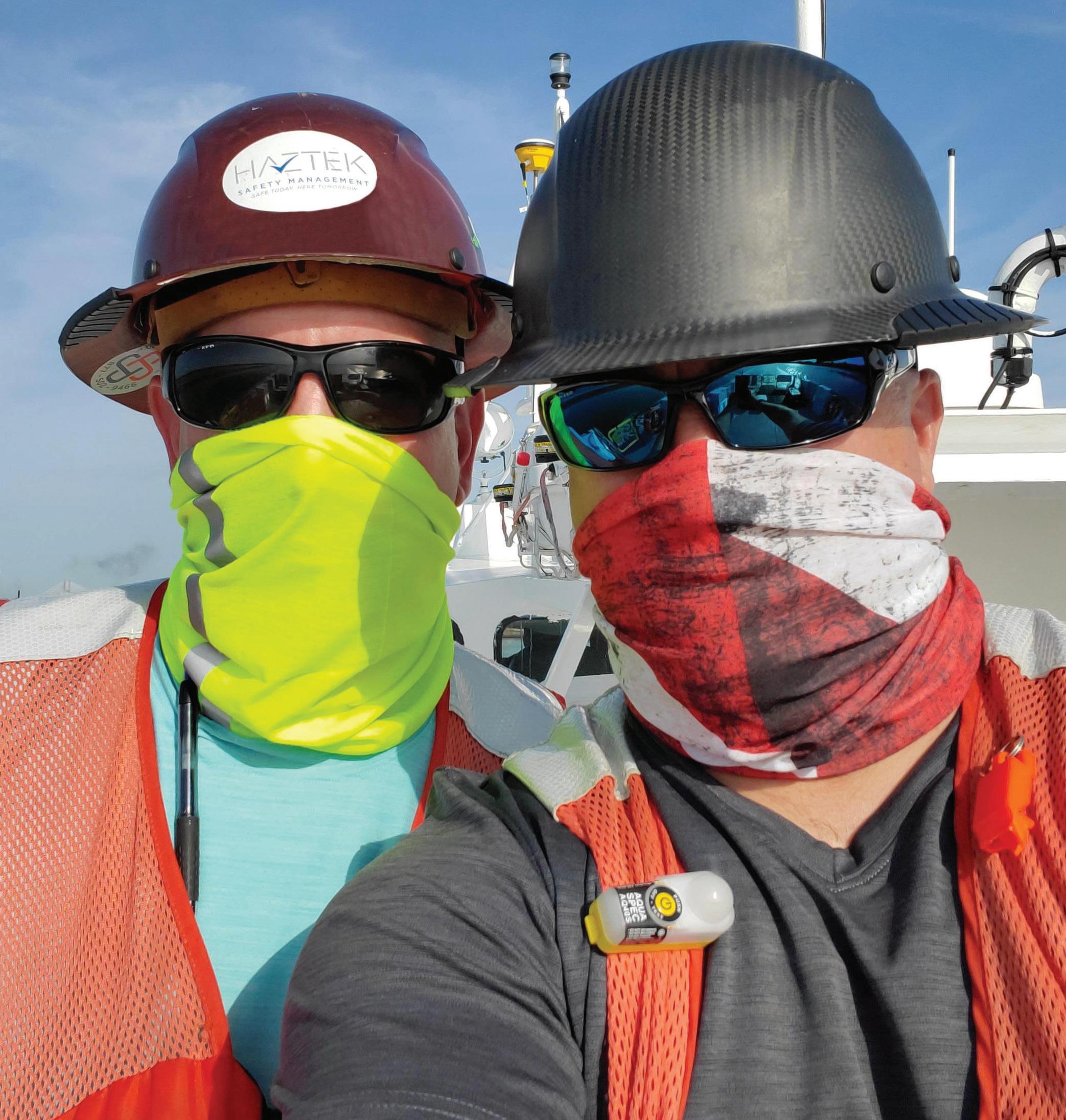The Safety Issue

Collaboration. Dedication. Solutions.





Fifteen years ago, I attended my first GBCA Annual Meeting. Today, I’m privileged to serve as Chairman of your GBCA Board of Directors. That’s the power of hard work and networking — and that’s the essence of GBCA. Making connections. Learning and growing. Building success. This is what GBCA is all about.

Our previous Chairman Michael Armento, our Board, GBCA staff, and our members have done a tremendous job elevating our association to where we stand today. It’s my goal to continue building on this good work as we remain focused on priorities that serve our members today and well into the future.
This includes investing in our many workforce development efforts that continue to gain traction, such as our thriving Construction Leadership Council (CLC). I had the opportunity to sit down with the CLC at a virtual Coffee Chat earlier this year and am genuinely impressed with the initiative that so many of our young professionals are taking to advance their careers and the companies they’re working for. They’re hungry to succeed, and their fresh new ideas will undoubtedly shape and strengthen our industry.
Safety will also continue to be an essential focus for our organization. Safety is more than fall protection, hard hats, cut resistant gloves, and safety glasses compliance. Safety leadership is not only about looking out for ourselves but more importantly, looking out for each other. We want to provide the tools and training that promote a culture of safety and health throughout the industry.
By further uniting our industry and working together, we’ll make this — and a whole lot more — happen.
Craig Melograno Chairman of the Board, GBCA President, PDM Constructors, Inc.2023 is an important year for the building industry and the city we call home.
With Governor Shapiro taking office in January and the election of new leadership for Philadelphia by year’s end, the time is now to stand strong together, forge new relationships, and leave zero doubt in anyone’s mind the building construction industry is a powerhouse for our region.
GBCA is committed to working closely with today’s and tomorrow’s elected leaders to advocate for our industry and your business. We’re making sure our positive impact on the economy and our communities is crystal clear. We’re showcasing our workforce development efforts as we connect Philadelphia’s diverse population with stable, familysustaining careers. We’re also providing visibility into how construction is enabling Philadelphia to solidify itself as a leader in healthcare, education, innovation, history, and culture.
The relationships we’ve built and continue to build are evident. We’re happy to have so many officials attend our events and receptions throughout the year, voice support for the building industry, and help us promote a fair, productive business climate for contractors and subcontractors.
Our longstanding partnerships with other trade associations also help us advocate for the best interests of our industry as a whole. Just as better collaboration during the building process yields better outcomes for owners, these partnerships only amplify our power as we work tirelessly on behalf of our members.
Benjamin J. Connors, Esq., CAE President & CEO General Building Contractors Association
It’s no coincidence that this year’s first issue of Construction Today focuses on safety. Across every inch of commercial construction, safety must always come first. It’s the foundation that builds successful teams and projects and a large part of what distinguishes the best contractors from the rest. And while the need for safety is ever present, it’s also a practice that’s ever-changing as standards and approaches are continually enhanced to protect the industry’s most valuable asset: our workforce.
As you’ll see in one of our feature articles, “Construction leaders step up to build a safer Philadelphia,” on page 28, GBCA is taking the lead in offering a full suite of resources — such as on-demand online safety trainings and more than 100 mobile-friendly Toolbox Talks — that help members and non-members stay at the forefront of safety. We’re also proud to continue our close partnerships with
OSHA, the Mid-Atlantic Construction Safety Council, and the Philadelphia Building Trades Council as we raise awareness for critical safety campaigns.
Throughout this issue, you will see other insightful articles from our members related to key aspects of safety, from company policies and culture (see “Culture Beats Compliance” on page 30), and individual mental health (see “Make Mental Health a Priority” on page 34).
It’s phenomenal to see how GBCA members are finding new ways to integrate safety throughout their firms and into every job. Keep an eye out for more information coming soon about nominations for GBCA’s Annual Project Safety Awards, which will be honored at our Safety Awards Reception in July. We’re looking forward to spotlighting even more members that are delivering projects with zero OSHA recordable injuries or illnesses, and showcasing their exceptional safety records.
Safety is everyone’s job. As we learn from and with one another in the spirit of continuous improvement, we will all grow stronger together.
Byron Lee, Ph.D. Senior Manager, Marketing & Communications General Building Contractors AssociationPUBLISHER/EDITOR Byron Lee

ADVERTISING/SALES Byron Lee
CONTRIBUTING WRITERS
Bill Burke / John Crain / Thomas J. Green / Byron Lee, PhD / Jeff Spatz / Mark TroxellKE
DESIGN Punch Garage
ACCOUNTING Kristin DeFrancisco
EDITORIAL OFFICE General Building Contractors Association, Inc. 36 South 18th Street Philadelphia, PA 19103 P: 215-568-7015 F: 215-568-3115
© Copyright CONSTRUCTION TODAY® registered in U.S. Patent and Trademark Office Copyright ©2004 by the General Building Contractors Association. All rights reserved. Submissions for editorial review should be sent to the editorial office address. Neither the publisher nor any individual associated with any branch of production, nor the advertisers will be liable for misprints or misinformation contained herein.
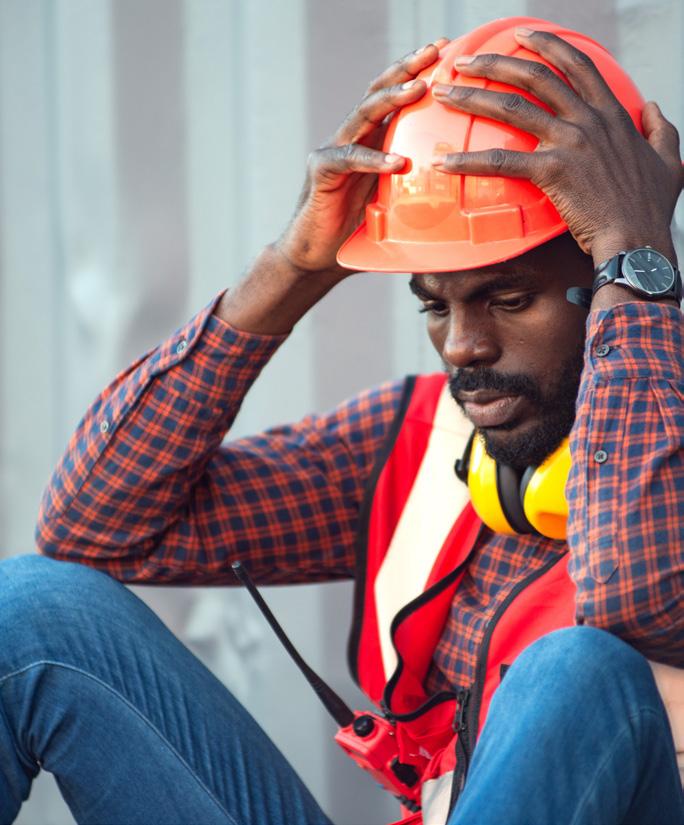




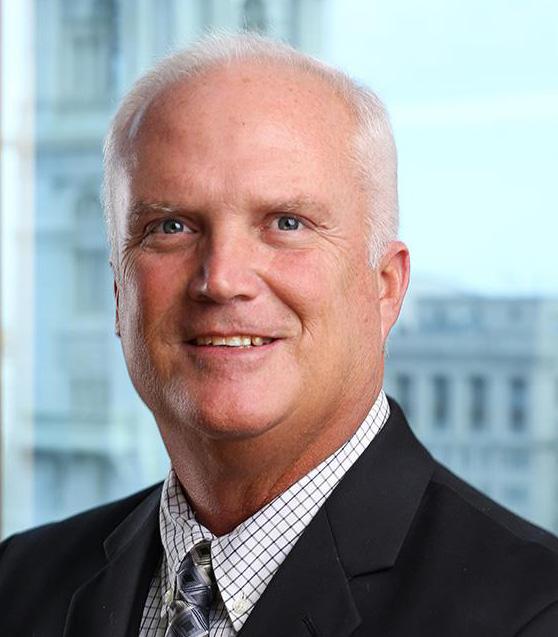




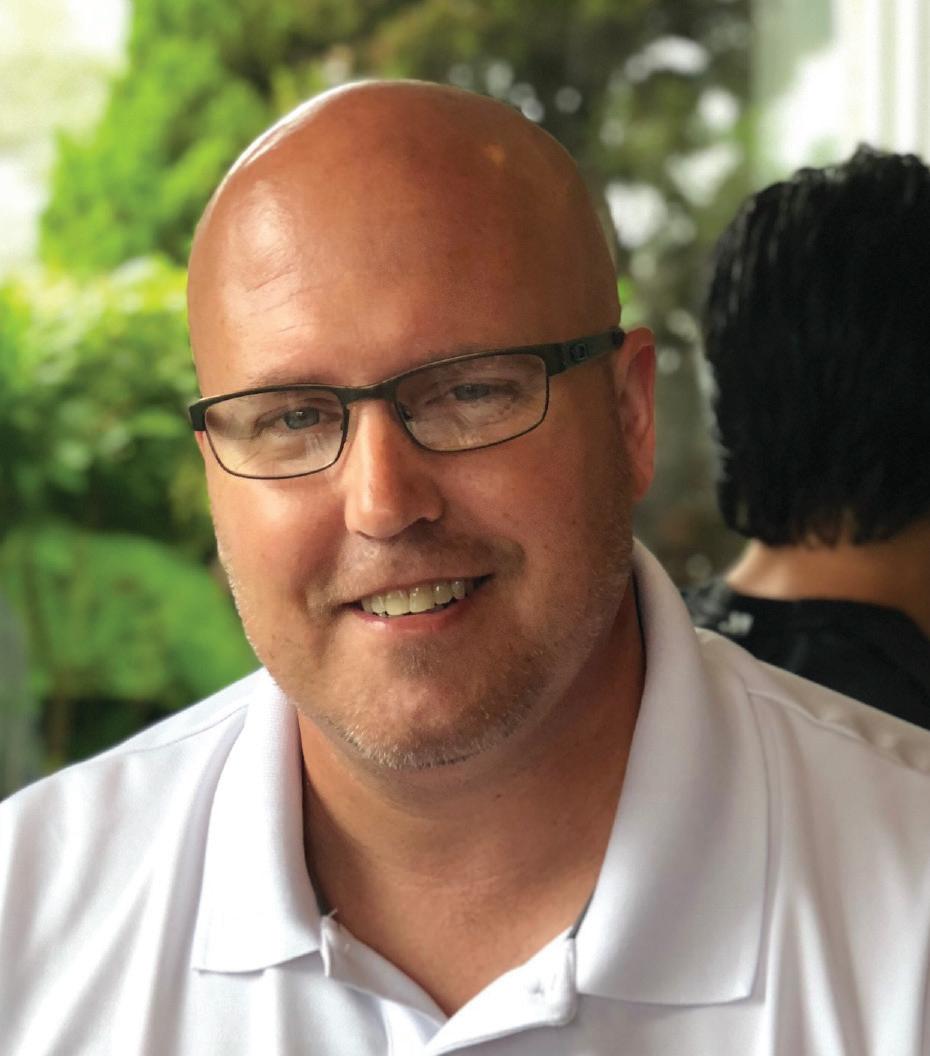






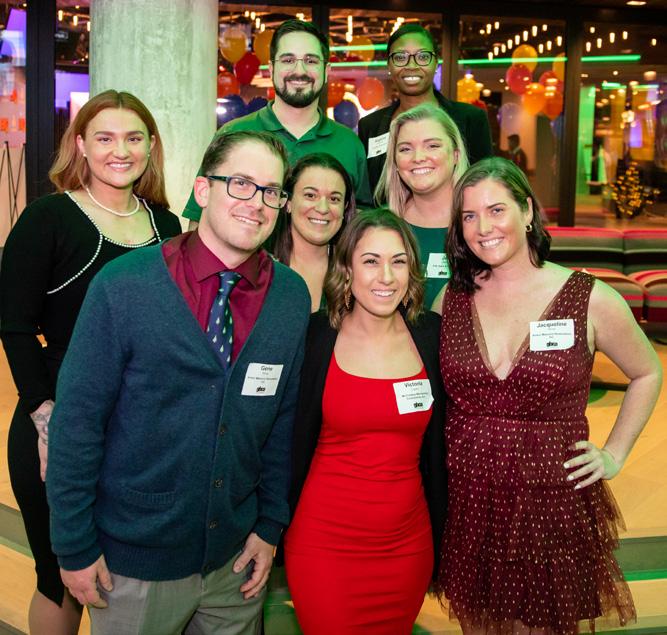
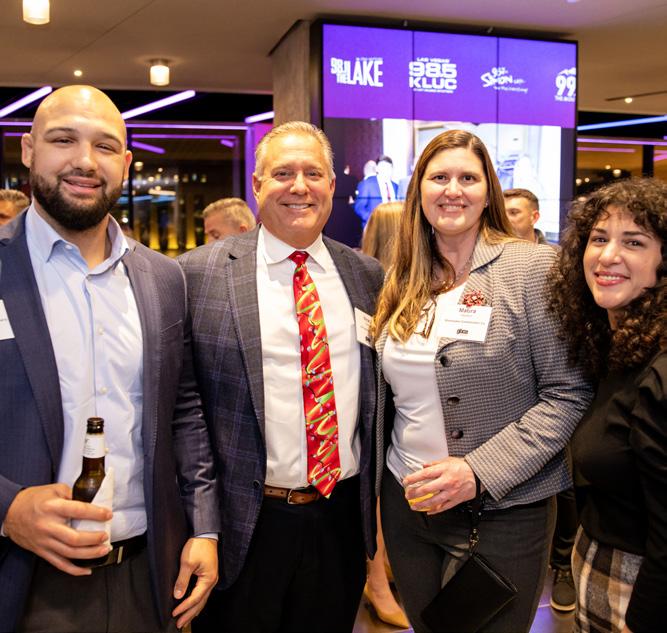
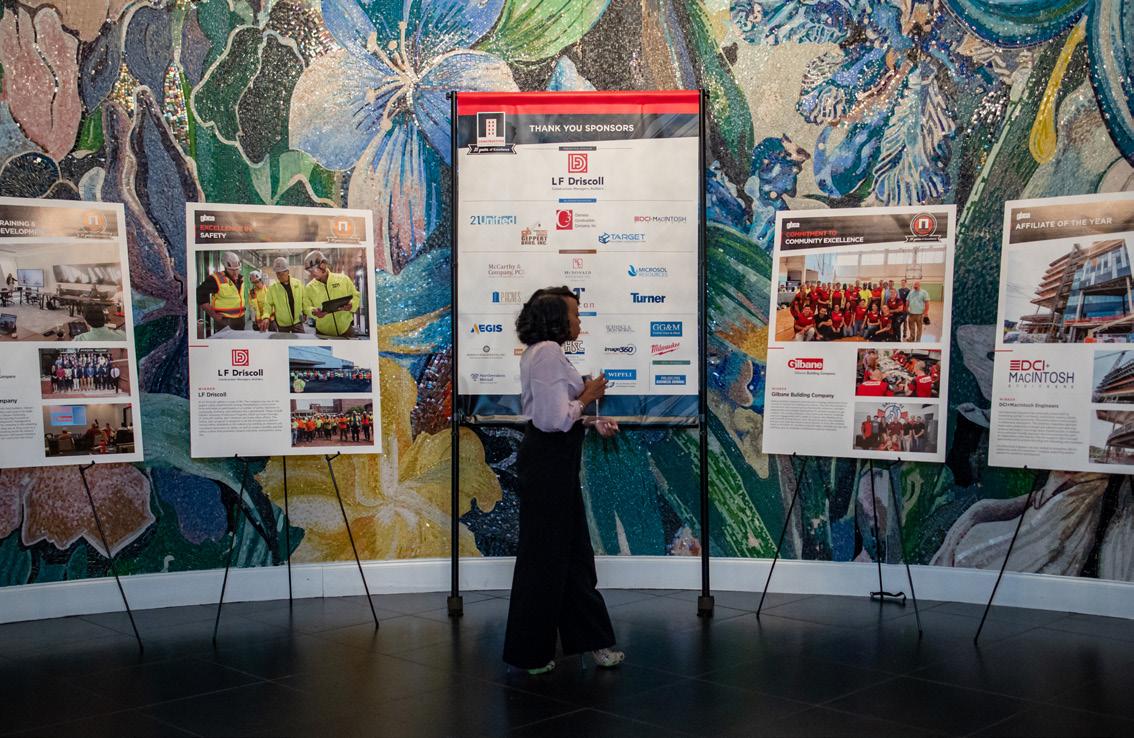

 2022 HOLIDAY PARTY
2022 HOLIDAY PARTY
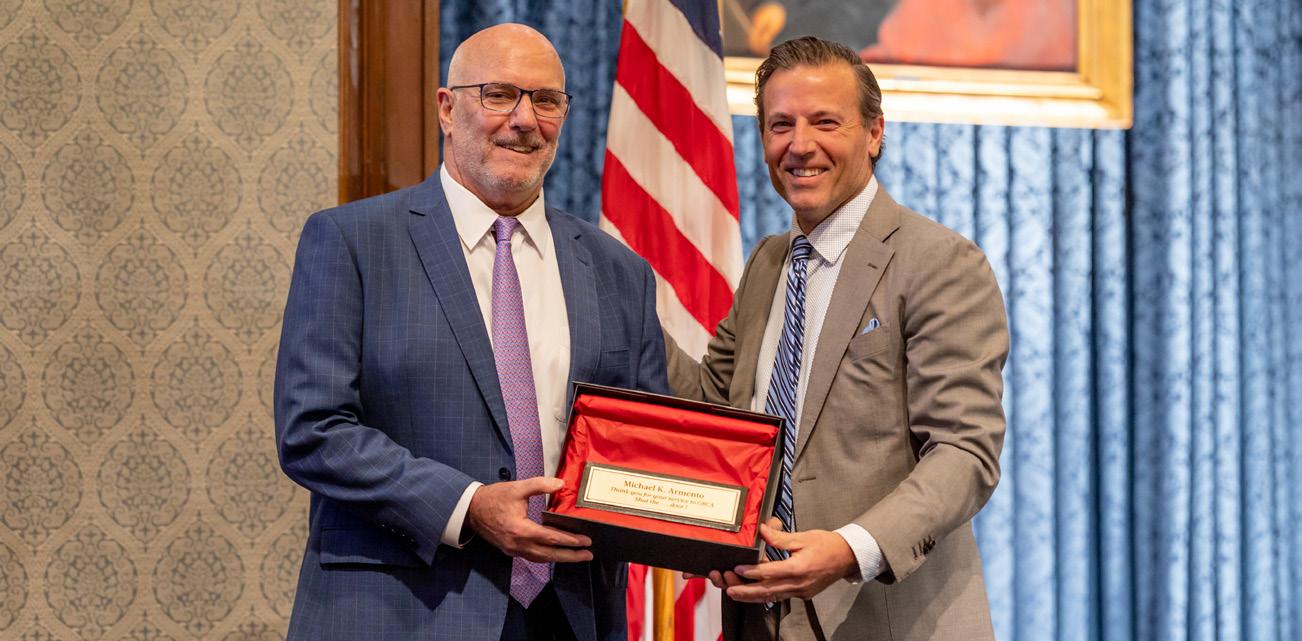

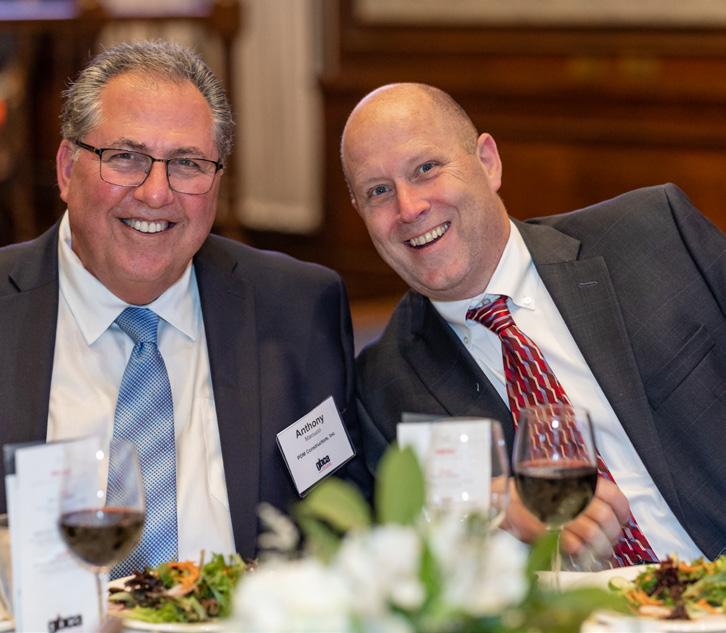

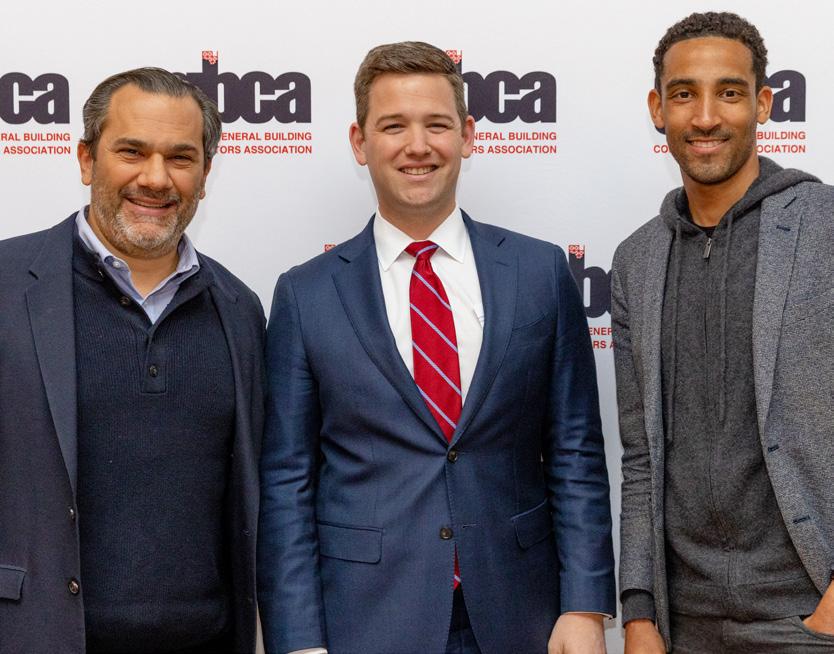


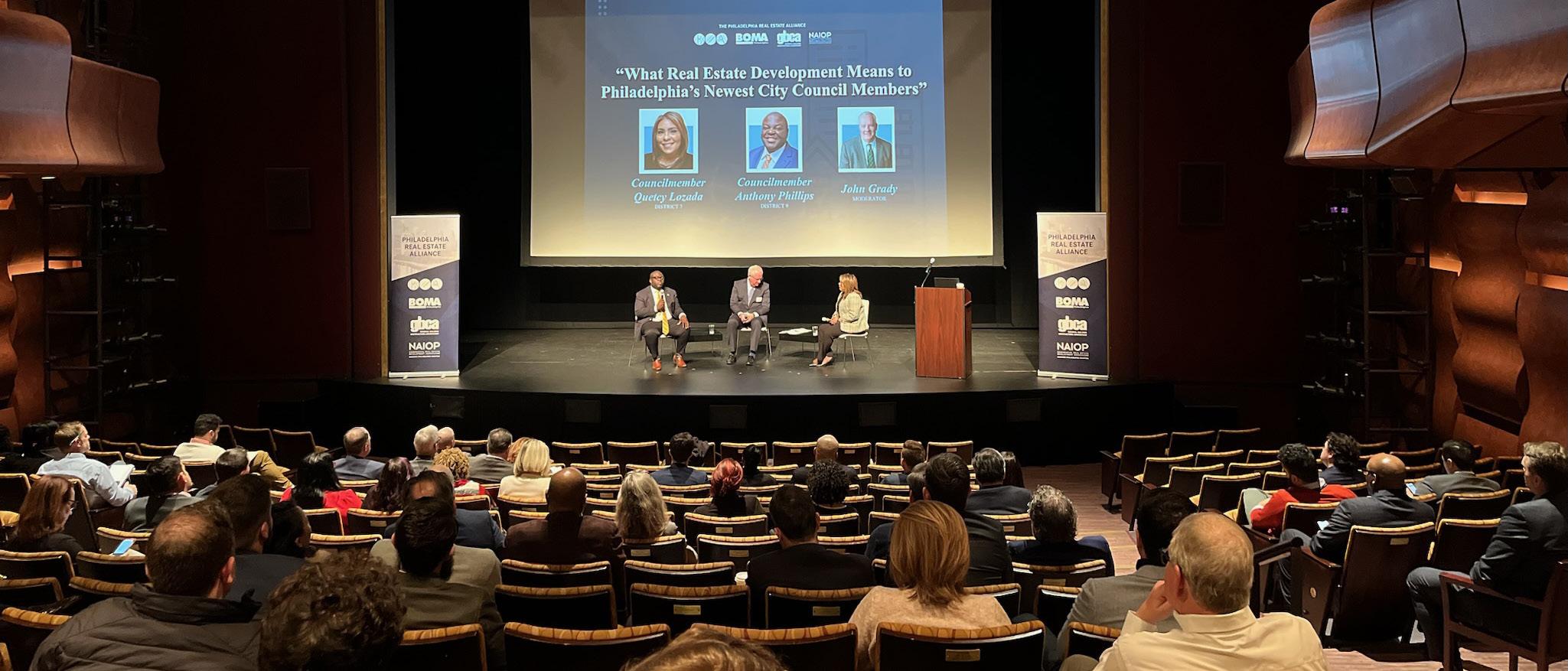
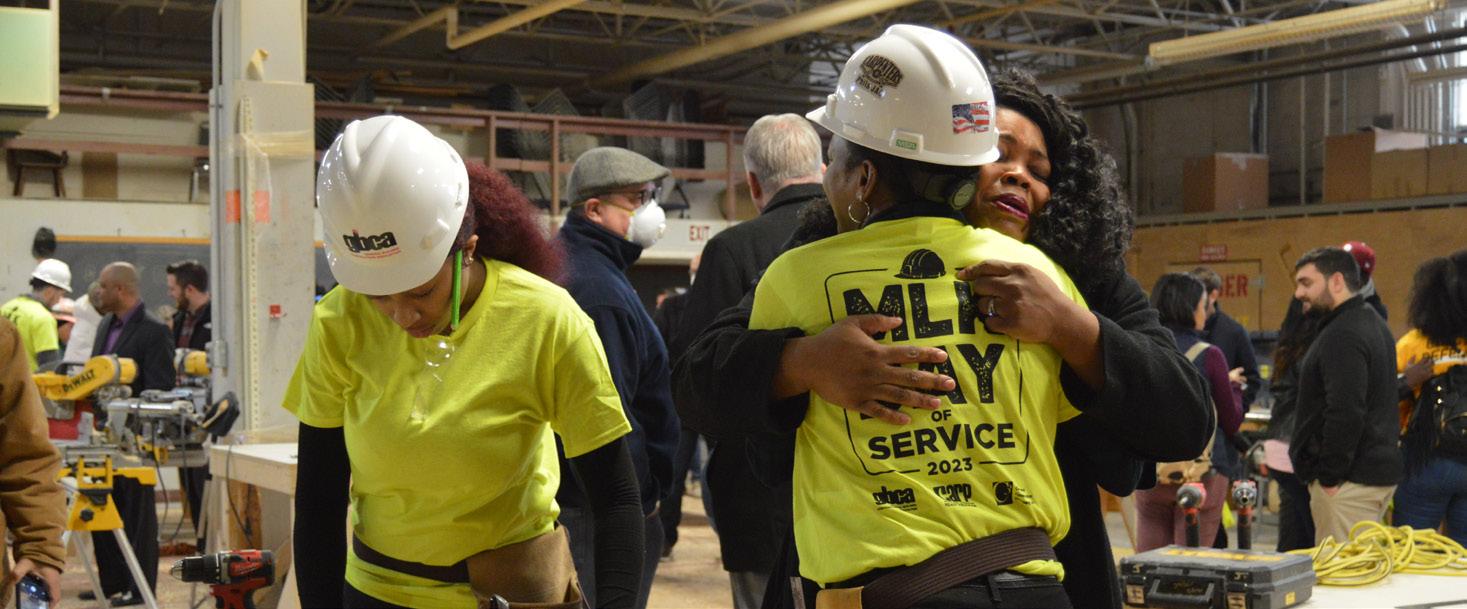

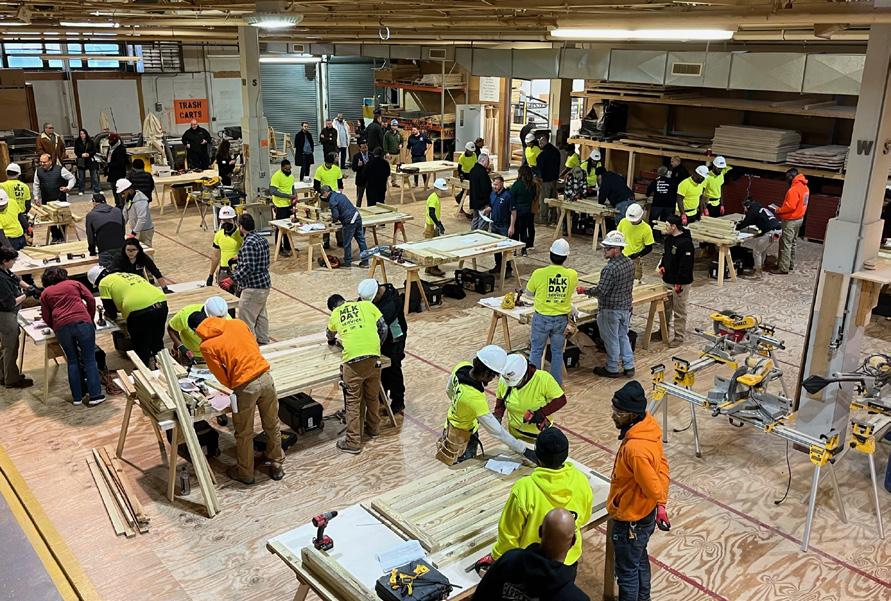
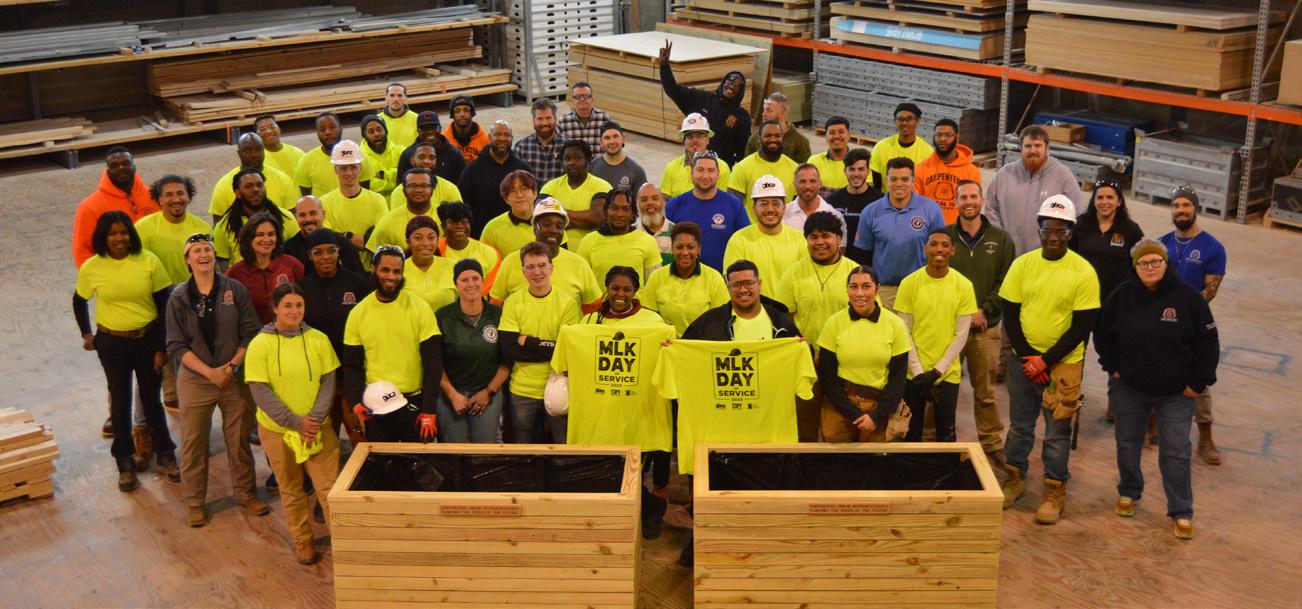

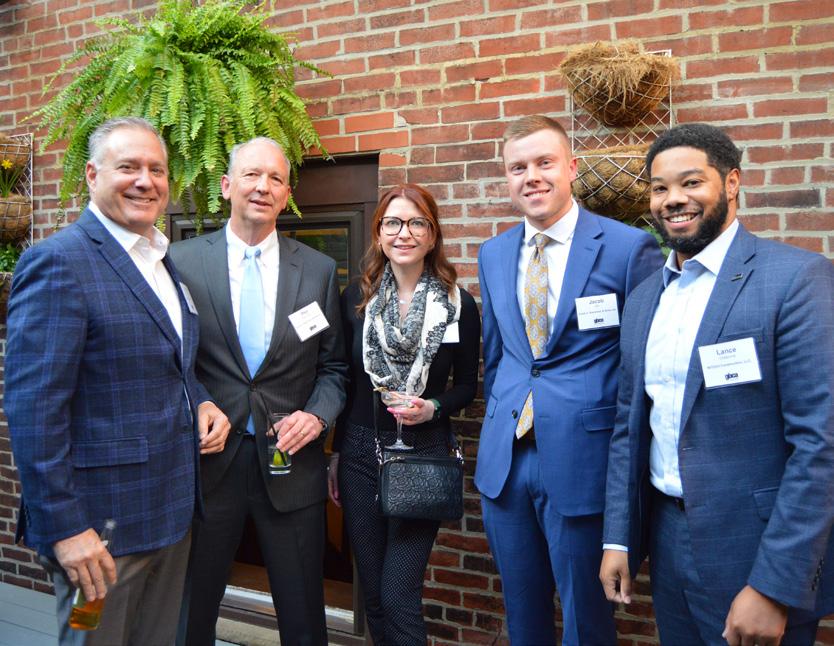


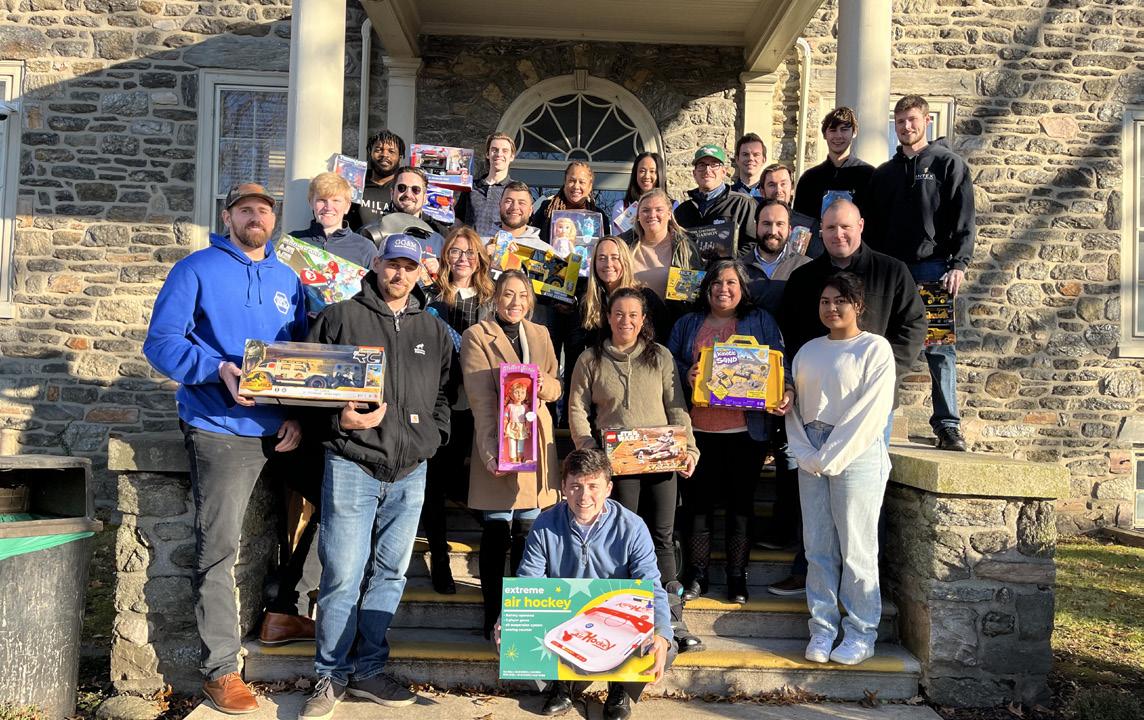

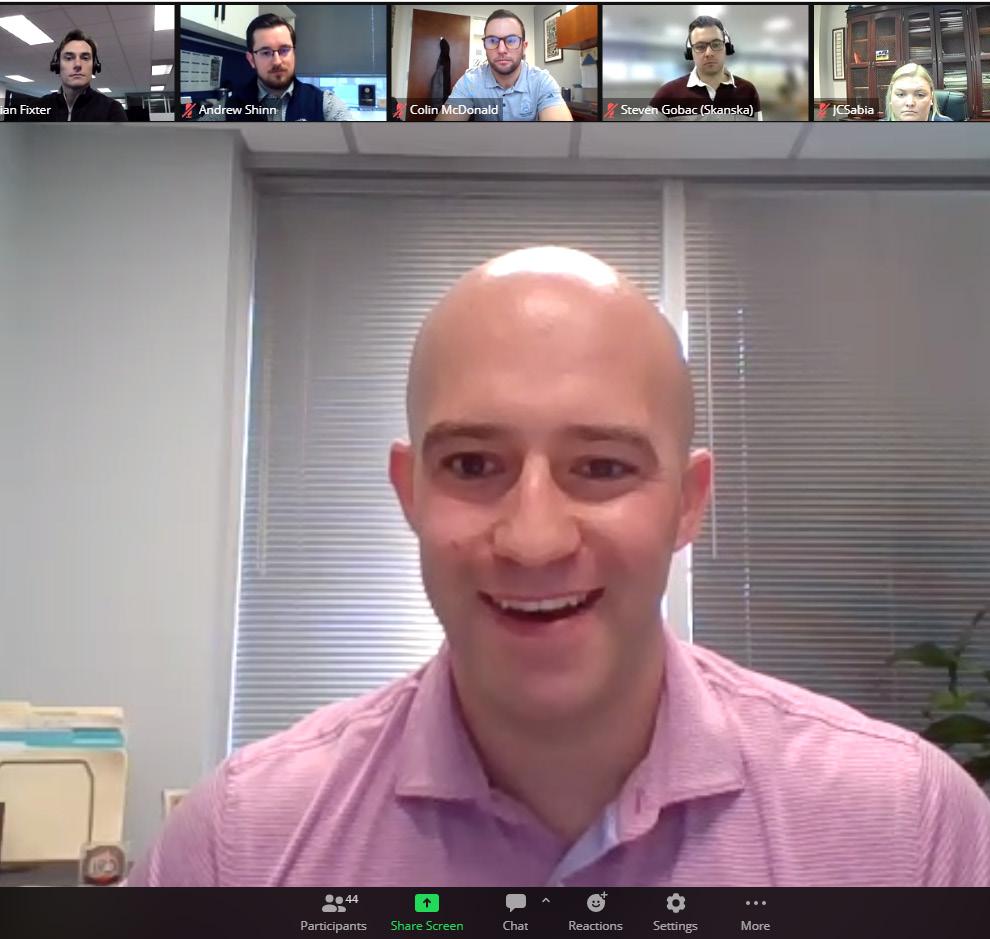
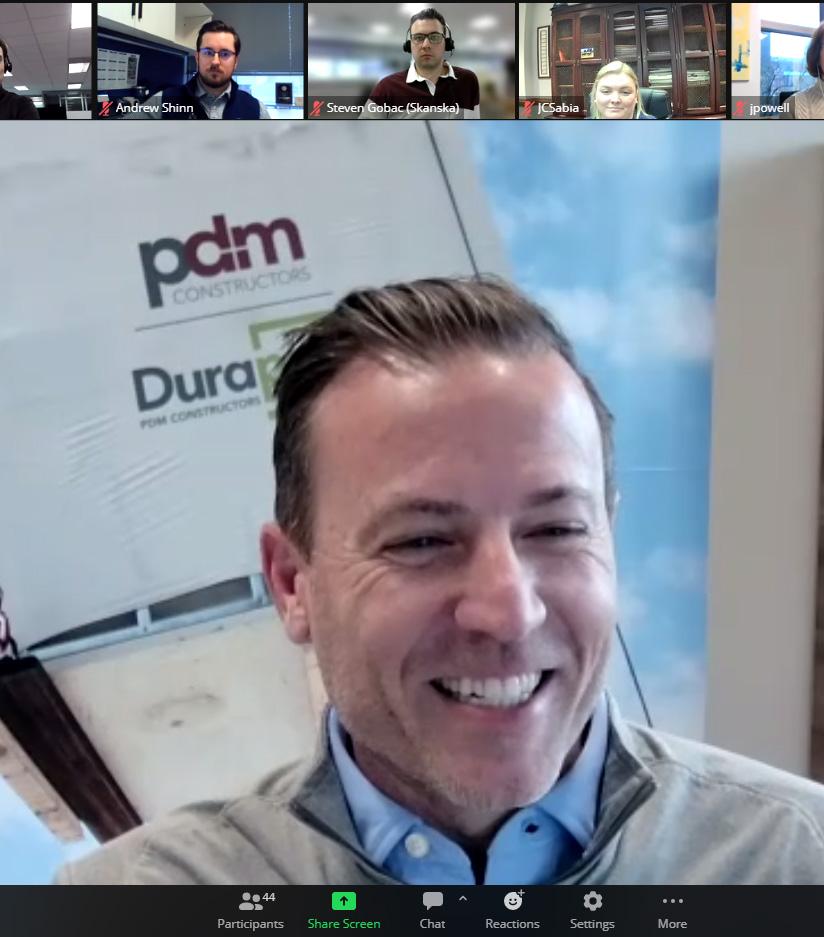
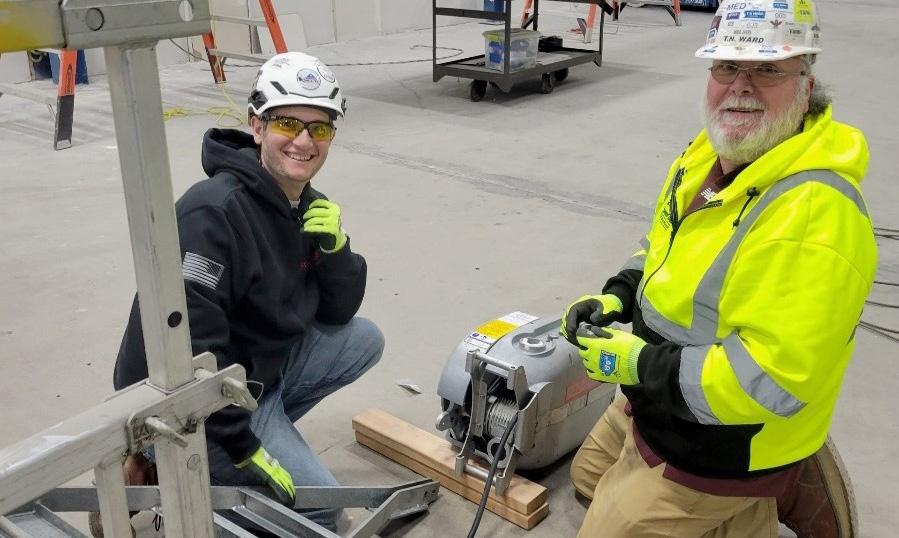


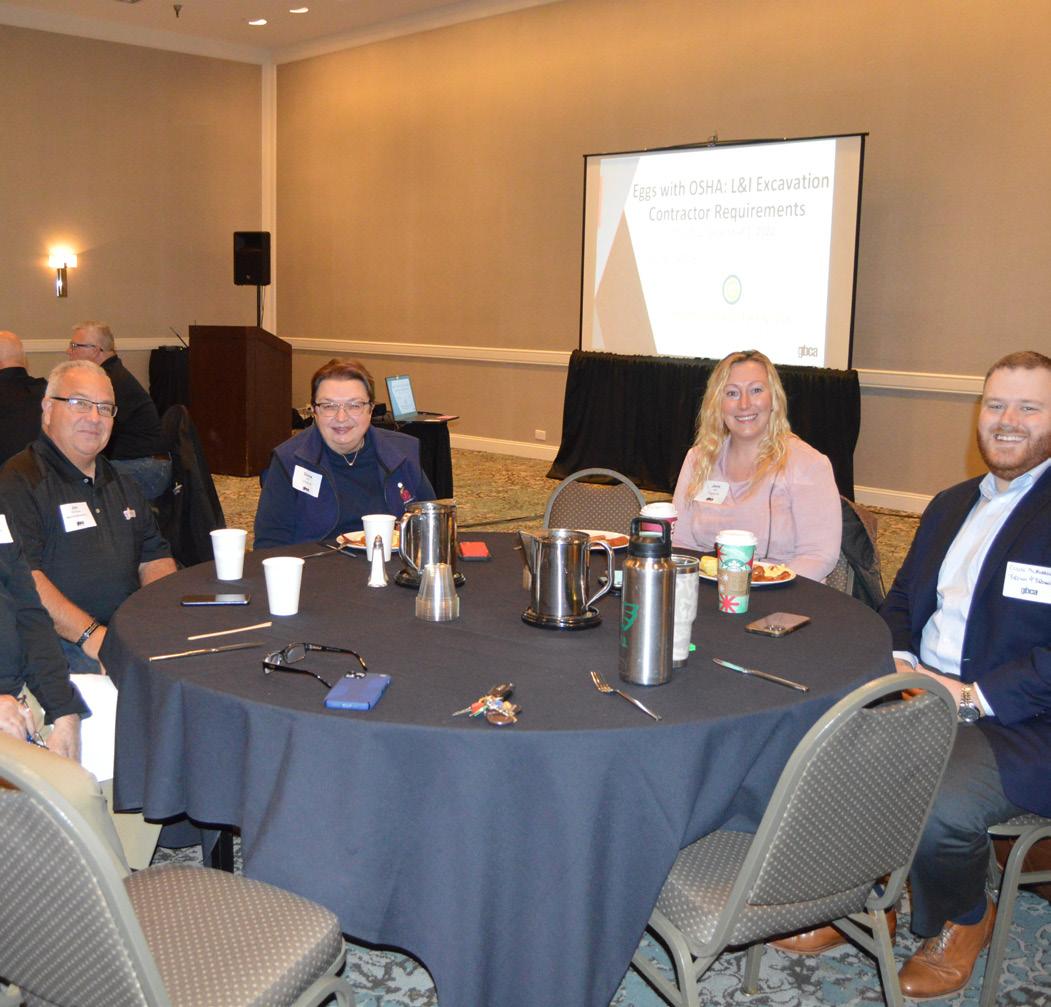

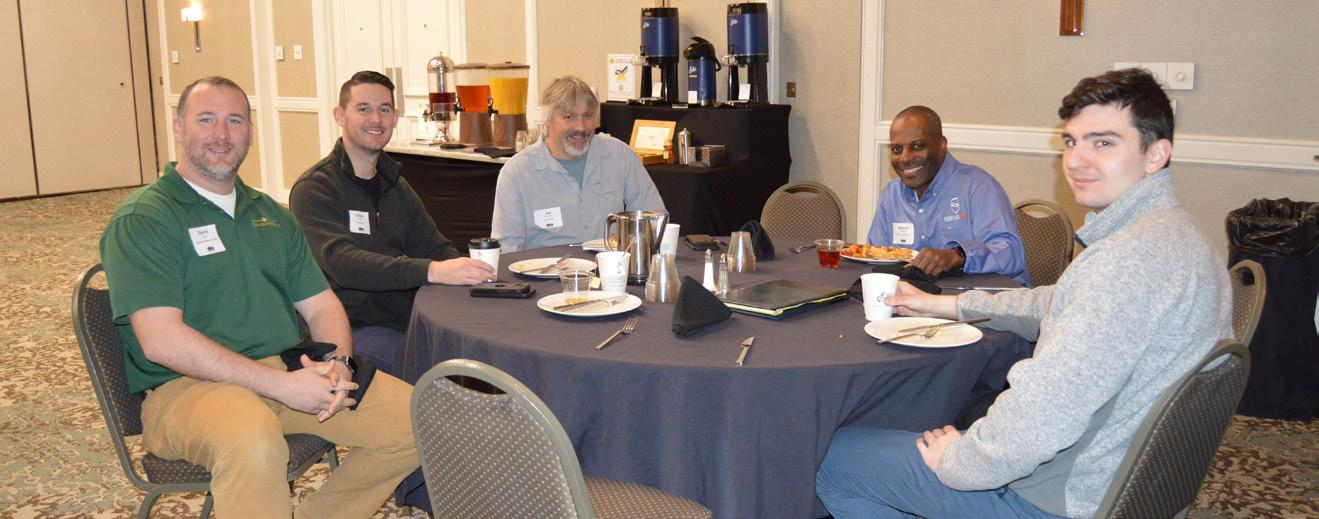


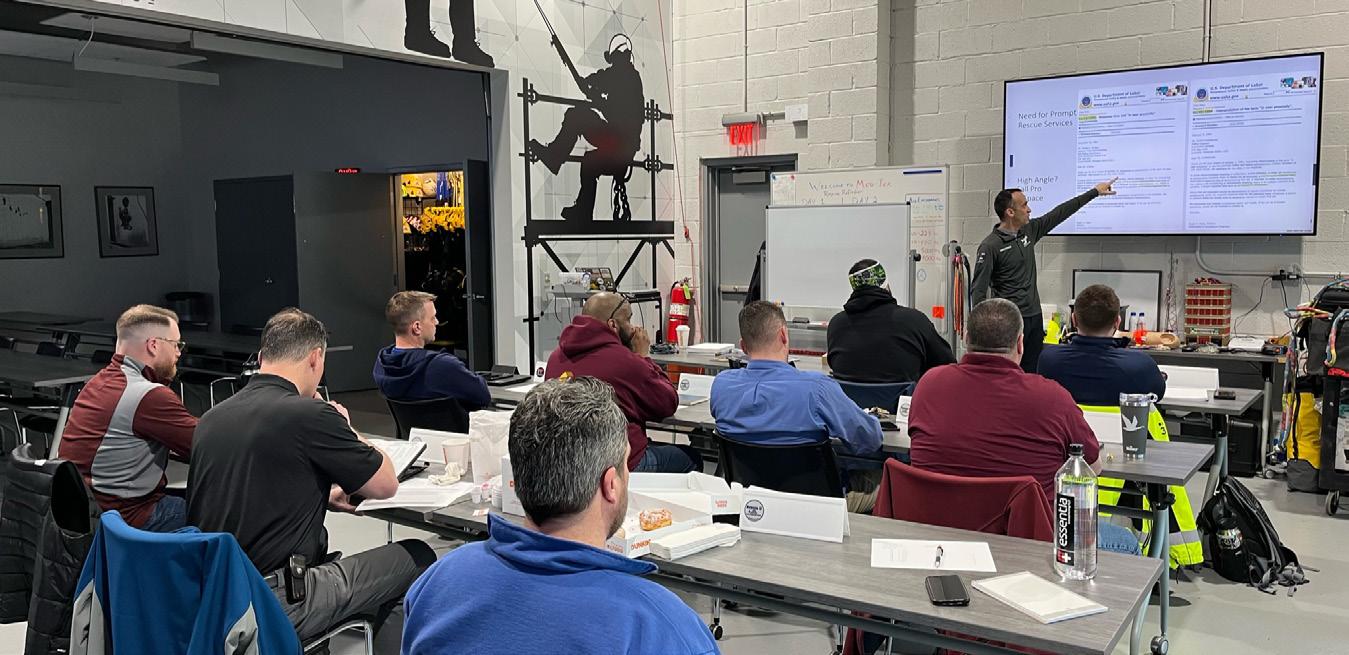
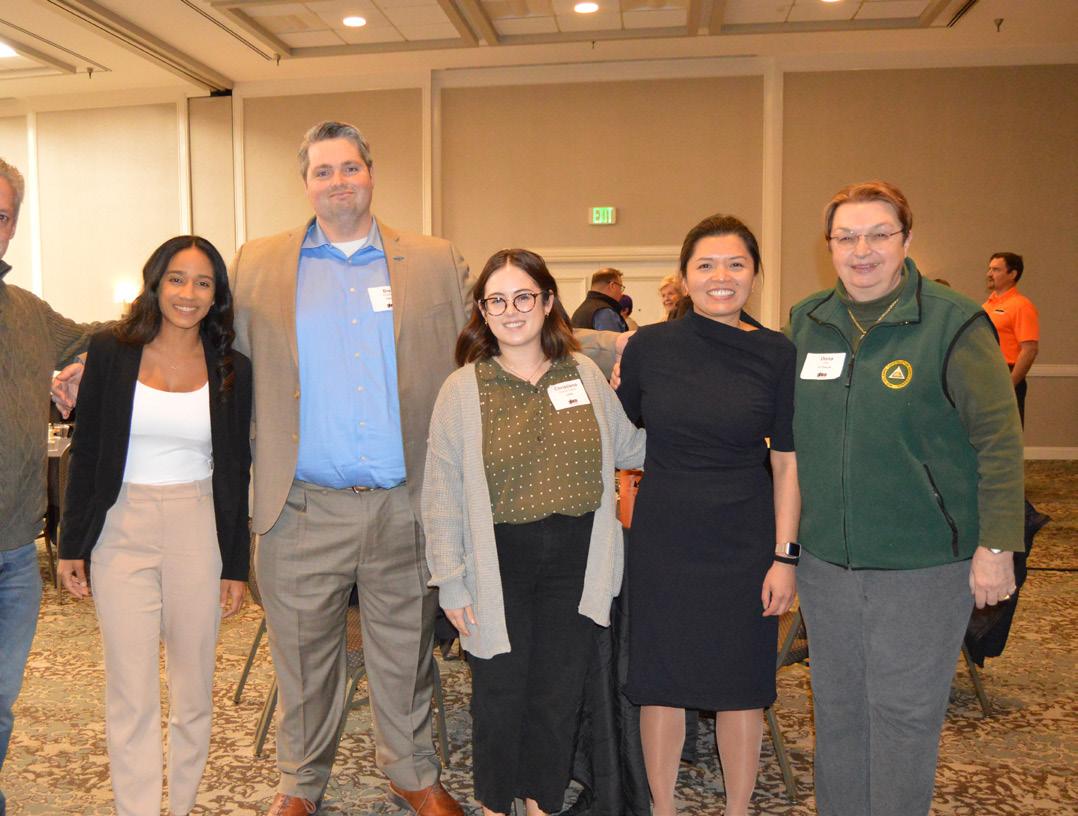

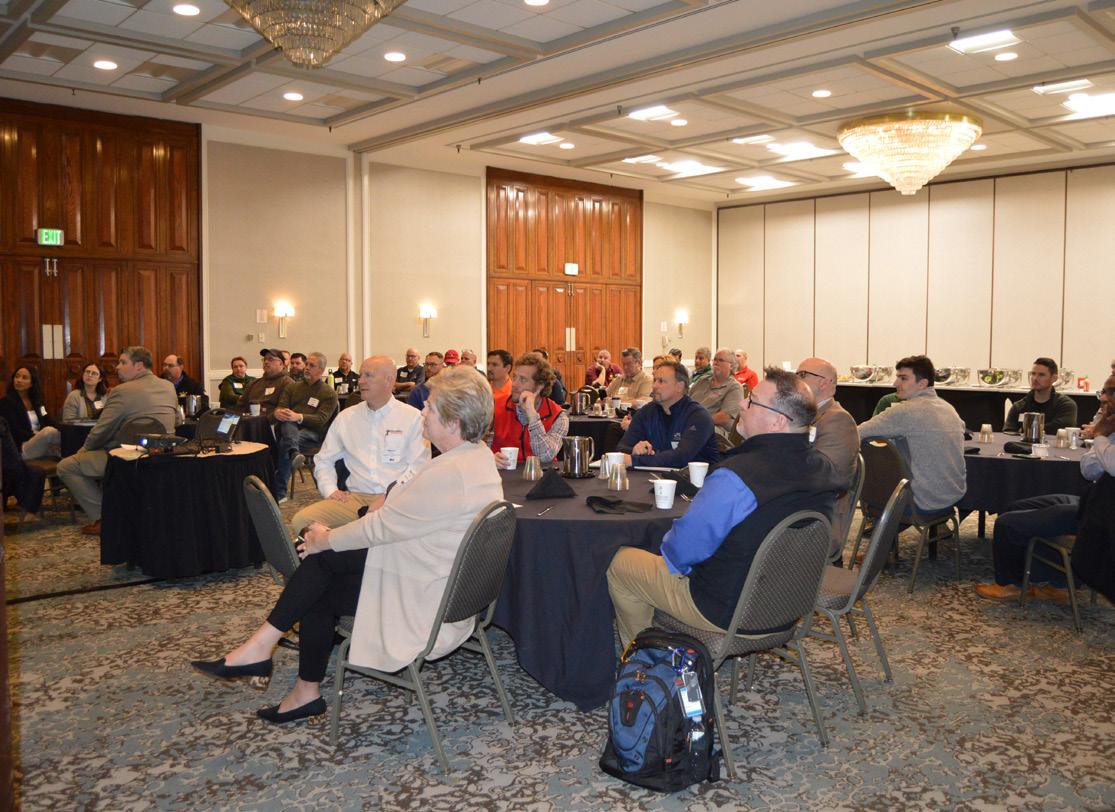
UNIVERSITY LEONARD AND HELENA MAZUR HALL LOBBY AND TERRACE RENOVATIONS
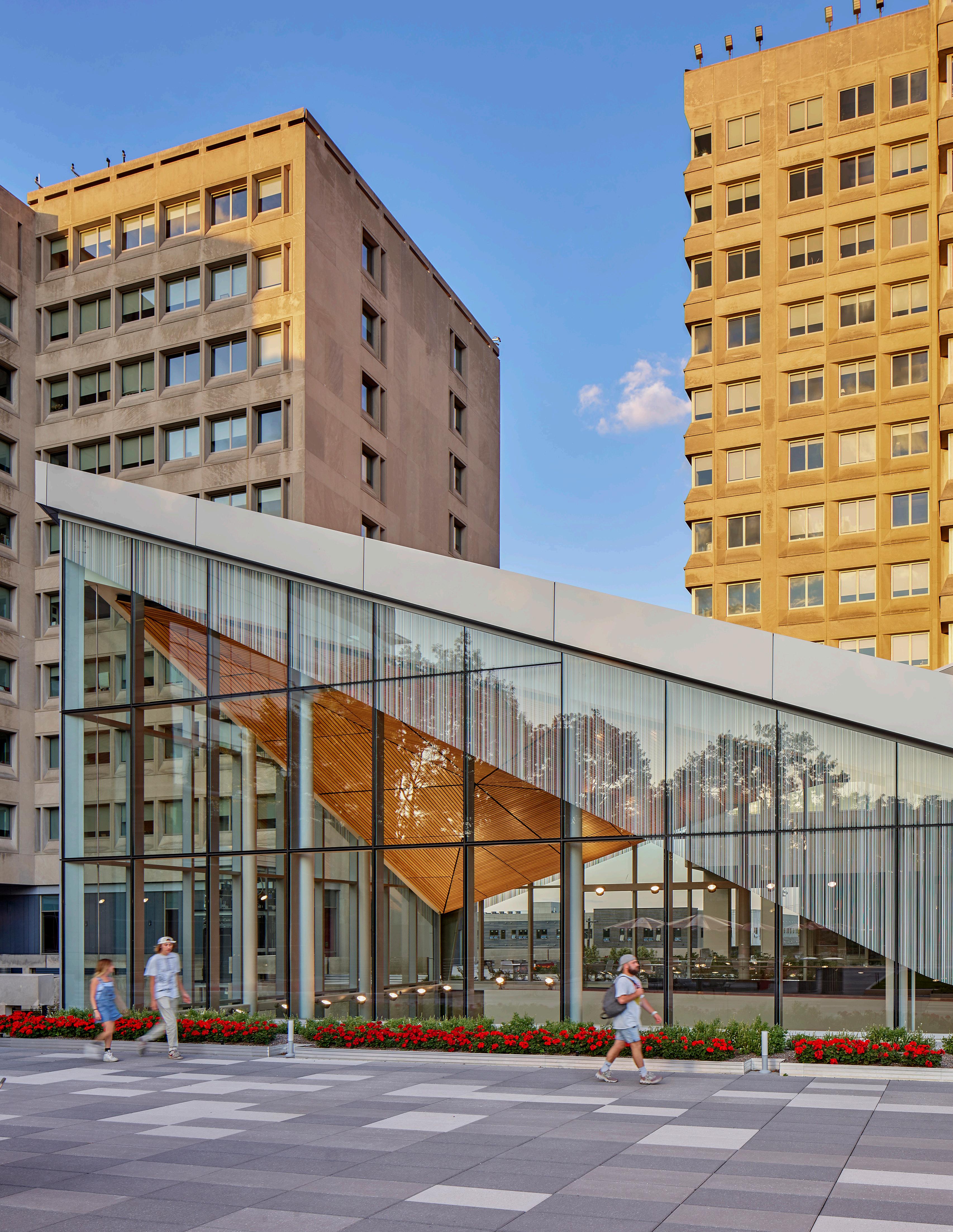
PROJECT NAME
Temple University Leonard and Helena Mazur Hall Lobby and Terrace Renovations
GENERAL CONTRACTOR
P. Agnes, Inc.
OWNER
Temple University
ARCHITECTS
Erdy McHenry (Atrium & Mazur Hall Lobby)
WRT (Polett Walk & Terrace)
ENGINEER
Urban Engineers, Inc.
COMPLETION DATE
September 2021
GBCA MEMBER COLLABORATORS
• American Floors, Inc.
• Anthony Biddle Contractors, Inc.
• Bencardino Excavating, Inc.
• Central Metals, Inc.
• Crescent Iron Works
• D’Andrea Bros. Concrete Co., Inc.
• Geppert Bros., Inc.
• Graboyes Commercial Window and Glass Solutions

• Intertek
• Joseph Dugan, Inc.
• Mayfield Site Contractors, Inc.
• Metal Structures, Inc.
• National Glass & Metal Company, Inc.
• Roma Steel Erection, Inc.
• Unified Door & Hardware Group, LLC, Tru-Fit Frame and Door
• United States Roofing Corp.
Located in Philadelphia, PA, Temple University has thousands of students, faculty, and staff on their main campus every day. The campus was lacking a common space for students and the larger Temple community to study, gather, and relax between classes. To create an inviting, centralized hub, Temple set out to transform various elements of Leonard and Helena Mazur Hall (formerly Anderson Hall), home to the College of Liberal Arts.
To achieve Temple’s vision, P. Agnes renovated the Mazur Hall lobby, existing interior and exterior spaces throughout Mazur and Gladfelter Halls, outdoor spaces outside of Mazur Hall and on the second-floor terrace, and improvements to Polett Walk.

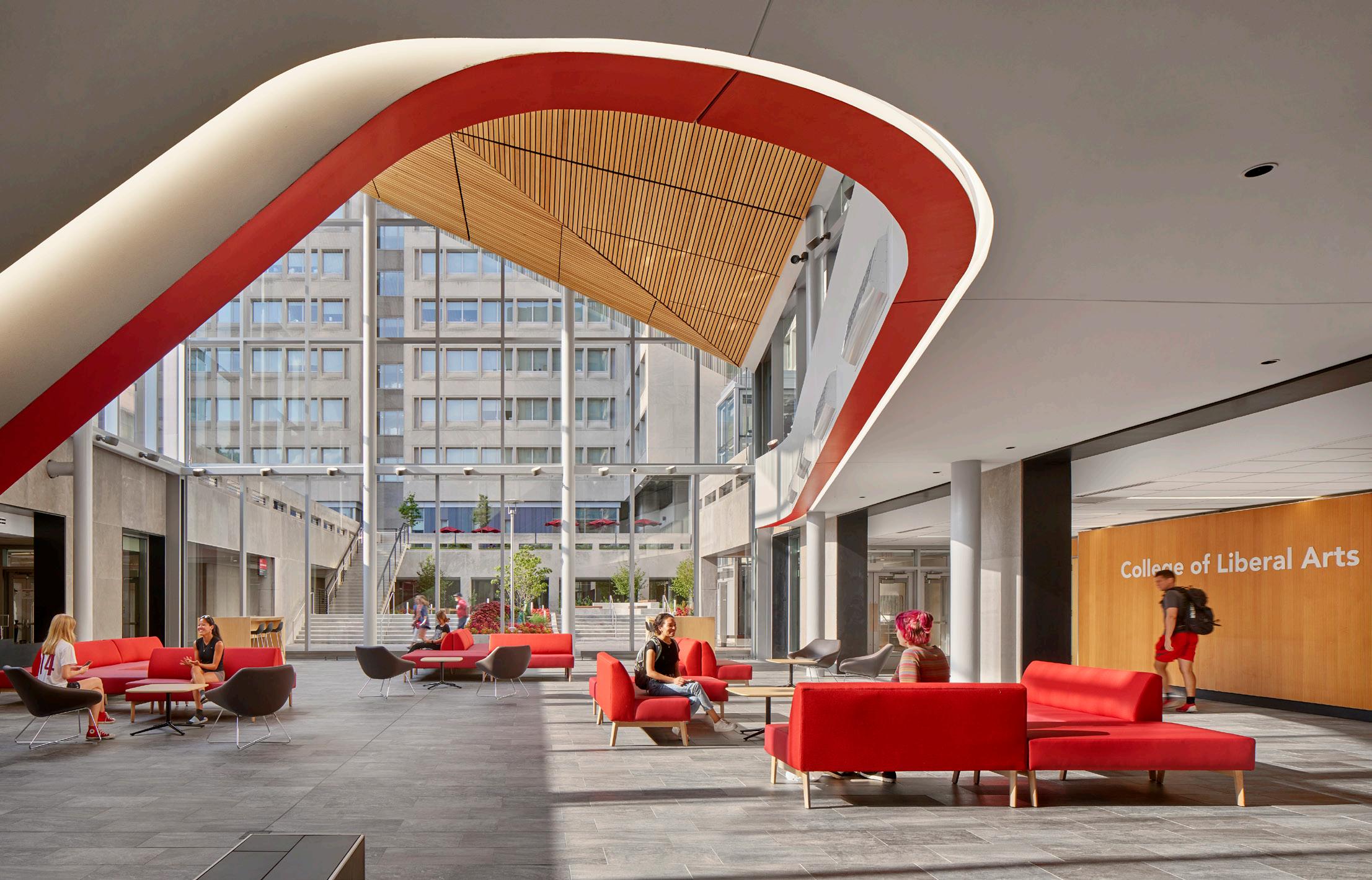
The renovations featured the demolition of an existing exterior courtyard which was surrounded by corridors and lecture halls. A new, glass atrium lobby was built within the courtyard and includes a curtainwall exterior with metal panel fascia. Interior details include new solid surface surrounds between new and existing spaces, a glass guardrail along the stairs to the terrace level which provides access to a new green roof. Renovations were also done in the surrounding Mazur Hall’s corridors, including ceiling and flooring upgrades to tie-in the new space.
The terrace level between Mazur and Gladfelter was transformed into a green space with abundant outdoor seating that is designed to accommodate social, professional, educational, and community functions. A new elevator was constructed outside of Gladfelter Hall to allow for additional access to the terrace.
Drone technology was used on a near-daily basis throughout the entirety of the building process. Drones were used for site documentation and progress tracking, including recording when work was completed, discovering site issues, overlaying markup plans, and more.
One of the biggest challenges faced on this project was the onset of COVID-19. For much of the project, on-site personnel were restricted, so drone technology also served as a safe “eye in the sky” for stakeholders from P. Agnes and Temple to track progress while remaining socially distanced.
This renovation project is the largest renovation project for Mazur and Gladfelter Halls since they opened in 1973. Ultimately, this project presents a new, centralized event venue and activities hub for students at the University while also providing unique views of Temple’s iconic Bell Tower. The Mazur Hall lobby offers a renewed prominence and added functionality for a previously unused part of the campus.



Name: Michael Knapp

Title: Project Manager
Age: 34
Company, City: Rycon Construction, Inc.
Philadelphia, PA
Years in field: 8
Education: SUNY at Oneonta, Bachelor’s Degree in Urban and Regional Planning and Bachelor’s Degree in History
Birthplace: Warwick, NY
City of Residence: Audubon, NJ
Q A
What is your business motto?
“What you put in, is what you get out”. I think it is important to always try your hardest at everything you do.
When did you first become interested in your career path?
I started at a very young age working for my father’s carpentry company and have always had a passion for construction. I always enjoyed building and seeing the end result of my hard work. I knew I wanted to stay in the construction world and when I discovered construction management, I knew it was the perfect career path.
What is the most rewarding part of your job? Least rewarding?
The most rewarding part of my job is watching all your hard work come together. To see an empty lot being turned into something that you put so much work into and becomes something that will be beneficial for your client. The least rewarding part of the job is dealing with unsuspected issues that hinder the flow of construction.
What is your biggest daily challenge?
Lead Times. I am very fortunate to work with a great team and excellent subcontractors that strive for the same goals, but material lead times are our biggest daily challenges currently.
How do you inspire your colleagues?
I work hard to have a positive attitude for the projects we handle. I think that many people can sometimes get bogged down in the negative aspects of their jobs and it can affect the people that you work closely with. I believe coming in everyday with a positive attitude helps inspire your colleagues to perform better. Also, a little sense of humor never hurts.
What goal are you currently striving to achieve?
My goal is to continue to progress forward in my project management career.
What project are you currently working on?

I am currently working on the EEW Monopile Buildings.
Do you have a life motto? If so, what is it?
My life motto is “Never settle as life is too short”. I believe that you should always be striving to move forward in your life and never stop trying new things or learning something new.
What’s the most important lesson you’ve learned in your career?
It doesn’t matter what college you went to or what degree you have if you are open to learning. There are many different paths you can take to get to the same ending.
What is/was your favorite CLC event?
My favorite CLC events are the Hard Hat Tours. I always enjoy getting a tour of the jobsites in the area and meeting other professionals in the industry.
How do you find that participating in CLC activities benefits you?
There are many benefits to taking part in CLC activities as you learn about different aspects of construction, you meet likeminded professionals and some activities you get to help others like when we collected food to Camp Out for Hunger.
Do you have any advice for other CLC members/ young professionals who are looking to advance their career?
Communication with your subcontractors, project team and owners is a very important part of construction management. Everyone needs to be on the same page and need to be aware of any issues or changes that are happening with the project. It also never hurts to ask questions.
What is your favorite thing about being a member of GBCA?
My favorite thing is to meet new people and network with other professionals in my field.
The construction world is not monotonous and it changes at a fast pace, daily, sometimes hourly. I love working at a fast pace and adapting to the challenges of the changes.
- Rain Catoia, Project Manager, Healy Long & Jevin, Inc.
There are no two projects exactly alike and each day has its own set of challenges. I’m constantly learning and growing, which is what I love the most.
- Jackie Harris, Lead Estimator, Torcon, Inc.
I love the teamwork it takes to get the job done efficiently and how I am able to learn something new every day.
- Riley Ehrhart, Junior Project Manager, Healy Long & Jevin, Inc.
The chance to see your hard work physically manifest itself. There’s nothing quite like walking past a building that you helped build years later or seeing that building help augment a city skyline.
- Meghan Brolley, Project Engineer III, Gilbane Building Company

I love that no two projects are alike, and every moment can bring new challenges with it.
- Susan Tully, Senior Project Manager, Gilbane Building Company

I love that every day is different. A new challenge to be solved always pops up, keeping work exciting.
- Meredith Zuno, Senior Project Manager, Gilbane Building Company



I love facilitating a building taking shape, knowing first-hand the countless details, and helping resolve the challenges of numerous buildings that have contributed to the growth of Philadelphia, the city in which I live.
- Margie Arendt, Project Manager, INTECH Construction, LLC


There is never a dull moment working in construction. It allows me to think outside the box to solve problems.
- Nicole So, Project Manager, INTECH Construction, LLC


The people. Construction is a team effort, and no one person does it all.
- Aisha Patel, Financial Engineer, Turner Construction Company

I enjoy that we construct/build projects that impact others. This is one of Torcon’s core values: Build meaningful projects that make a fundamental difference.
- Jaime McGeehan, Senior Project Manager, Torcon, Inc
Women in Construction Week was founded by The National Association of Women in Construction (NAWIC) in 1998 to celebrate and promote the role of women in the construction industry across the country. This year, Women in Construction week was celebrated March 5-11, and GBCA spotlighted women working on construction project management teams.

Leave your ego behind, but never underestimate your abilities. It is impossible to know everything, and you must be willing to learn and accept help.
- Bailey Allmond, Project Engineer II, Torcon, Inc.
Put in the work and know your worth. Especially as a woman working in a male-dominated industry, learn to uphold an unwavering level of confidence in your abilities, experience, and value.
- Alyssa Killian, Estimator, Torcon, Inc.



Be relentless. This industry is filled with individuals eager to share their knowledge, so take advantage of their wisdom. Pick yourself up when you fail, forgive yourself for not being perfect, and keep moving forward.
- Colleen McCann, Project Manager, Healy Long & Jevin, Inc.
Have confidence in yourself. Navigating a male-dominated industry has specific challenges, but don’t be afraid to ask questions and go outside of your comfort zone!
-Lindsay Roy, Project Coordinator, Healy Long & Jevin, Inc.
Spend as much time and effort on building relationships as you do technical knowledge. Boats don’t move forward unless everyone paddles!
- Laura McNeill, Engineer, Turner Construction Company
See as much as you can. Go on jobsite tours, intern, reach out to people in the industry and ask them what it’s like. The more you see, and the more people you can talk to, the more prepared you’ll be.
- Kate Flint, Engineer, Turner Construction Company
Always be curious. Develop genuine relationships. Ask questions, especially to the tradespeople as they are the experts in their fields. And lastly, don’t be afraid to get out of your comfort zone, always seek out opportunities for growth.
- Ruisa Hinds, Cost Analyst, Turner Construction Company

Don’t be afraid to ask questions! Whether you’re asking a project manager, superintendent, tradesman, or another construction professional, everyone is willing to take the time to explain the details of a project
- Kassandra Sloan, Project Engineer I, Gilbane Building Company




There is always something to learn from anyone in this field despite their rank. Organizations such as CREW, PWC, and NAWIC are composed of women who are committed to nurturing and helping other women. Get involved.
- Colleen Mills, Project Director, INTECH Construction, LLC

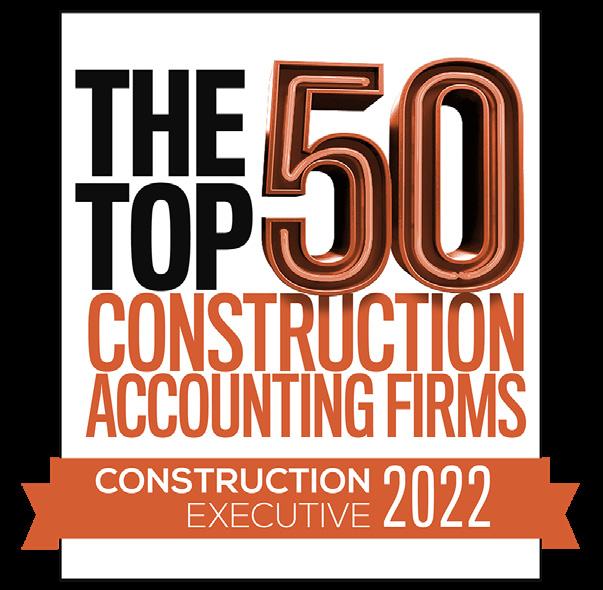




Jerry walked into the meeting feeling excited. The project team for a new proposal was being announced, and he was hopeful that he’d be named to the team. He had joined the company right out of university, and five years later, even though he was still the newest member of the team, he had worked hard and was no longer the lowest ranking member. He felt good: his peers, like Mark, who he now shared rank with, had been great sources of support and they worked well together. His boss, Tony, also knew that he wanted to pursue more responsibility, and was putting him onto more challenging projects, which had helped him prove himself and get promoted faster.
As Tony handed out the project assignments, he got to the one proposal and said that two members of Jerry’s team would be listed as part of the overall project team, and that Jerry and Mark would be leading their department on the project. For Jerry, this was great news; this was an opportunity to do more in the department.
When the meeting ended, Mark turned to Jerry, “Hey, looks like we’ll be working together closely.” Jerry nodded. “Well, I’ll get started on creating a work plan and establish our responsibilities,” Mark continued, “but just to let you know, I’ll be taking the lead and you’ll be helping me.”

“Sure,” said Jerry. It hadn’t sounded like Tony wanted him to only assist, but he didn’t want to pick a fight either, especially not so soon after the meeting and while they were still in the conference room.
“Hey, Mark, Jerry.” Tony cut in, apparently having overheard Mark’s comment. “Actually, I meant that Jerry was going to be the lead and that you, Mark, will be helping him.”
“Oh, okay,” said Mark. Tony left the room. Mark turned again to Jerry, “Well, I guess that clears things up.”
“Yeah,” Jerry said.
“Cool,” Mark said. He started gathering up his things. “Listen, I’ll check back in with you later. I need to talk to Tony for a minute.” He stepped out of the conference room and headed down the hall towards Tony’s office.
Jerry headed back to his desk. He was looking forward to working on the project and hoped that this wasn’t anything to worry about.
The next morning, Jerry was pulled into Tony’s office, along with Mark.
“Look,” Mark started, “I don’t think that Jerry is the right person to lead this project. He doesn’t have enough experience yet to deserve being named the lead. The lead should be me.”
Tony sat up and leaned forward. “I want to reiterate that for this project, I am putting Jerry in the lead. I want Jerry to get more formal experience taking the lead and managing other people. I think that this project would be a good one, since you two are at the same level in the company and as for managing, well, this is a team that gets along, so it’s an ideal one for him to manage.”
After the meeting, Jerry took a walk to clear his head. As they left the room, Mark didn’t seem upset with him, per se, but he had said that Jerry didn’t deserve to be in the lead position. Mark had been someone who he related to at this point, since they were doing a lot of the same tasks and had a similar workload. In fact, Jerry thought of Mark as one of his mentors, so it stung a bit to hear Mark say what he said, especially in front of Tony. Did Mark not take him seriously as a colleague?
I guess I’ll just have to prove myself, thought Jerry. At least Tony believed in him. I can’t let Tony down, and I’ll just have to figure out how to keep things good with Mark.
A few days later, Tony also let Jerry know that he was including Jerry’s name in the project proposal. He wasn’t the overall project lead, but his name would be included as one of the team.
Jerry’s phone rang. It was Cheryl from Business Development and Marketing. She needed to verify some points on his resume, including his overall number of years of experience.
He told her five, and there was a pause: “Huh. I’m really surprised that someone with that little experience is allowed to be named onto this project,” she said.
“Um, well, what do you mean?” Jerry asked. The comment was a bit pointed. Maybe Cheryl didn’t mean to come off so bluntly.
“I just don’t think that it will look good to the client when we propose someone with that little experience.”
“Oh, okay. Well, if you need any other information from me, give me a call.” Jerry hung up the phone.
Jerry let out a sigh. He knew that Tony put him onto this project for a reason, but did others in the company see him as a liability for this proposal before it’s even submitted? He thought that he had a pretty good track record so far, one that included good quality projects and working well with team members, and this record got him promoted. He also wasn’t burning out.
But even though he knew that his work was good, a nagging question stayed with him: What number of years of good work would finally count as enough experience for him to be deserving of respect from others within the company, let alone the industry?
Three Dale Carnegie trainers offer expert analysis and advice.
I’m sure that many of us can relate to this scenario. We work hard, do our research and make good decisions based on the facts – yet someone still questions our conclusions. How frequently this occurs may decrease over time, but it will probably never disappear completely.
The question, “What number of years of good work would finally count as enough experience for him to be deserving of respect from others within the company, let alone the industry?” is the wrong question. The question we should be asking ourselves is, “what can I do differently to increase the level of trust, credibility, and respect in this relationship?” The answer is going to vary depending on the other person, the relationship and the specific topic.
We know:
• Trust is built by keeping our promises and destroyed by letting people down,
• Credibility comes from supporting our views and opinions with evidence, and
• Respect comes to us when it flows from us.
So while there is no specific timeline for earning someone’s trust, there is one specific action we can take to accelerate the process – be trustworthy!
It’s unlikely that Jerry can say anything that will change the minds of his colleagues who question his managers decision to assign him with the lead role on this project. He should avoid directly defending himself or his manager’s decision. Dale Carnegie says, “Evidence defeats doubt.” As Jerry focuses his time and mental energy on managing this project as successfully as possible, rather than on the opinions of those who disagree with his role, he will make positive and constructive strides toward a successful project and building up his credibility. Effectively leading the project to completion is the best kind of evidence and doubts will fade into the background.
Jerry also has an opportunity to reframe how he views the situation, and that will impact what happens as well. His manager clearly believes in his capabilities and is offering this opportunity for Jerry to grow as a leader! Jerry should trust the experience of his manager and seize the opportunity with enthusiasm.
A key contributor to his success will be to focus on open communication and collaboration. Mark may feel overlooked or possibly resentful about not being selected as the lead. Jerry should focus on strengthening his relationship with Mark by acknowledging the value Mark’s expertise and insights bring to the project team. Dale Carnegie says, “Make the other person feel important and do it sincerely.” This is not a manipulative tactic: Rather, Jerry would genuinely recognize Mark’s strengths, respect Mark’s important role on the team, and foster a spirit of collaboration on the team. It takes confidence and leadership to do this and this approach can result in a winwin scenario!
Actions speak louder than words!
Jerry has worked hard for the last five years to prove himself. He was able to build his credibility, enhance relationships, and achieve results. He has clearly been working toward taking the next step in his career and this opportunity is evidence of that! Jerry should keep believing in himself!
There always will be some level of conflict or miscommunication in business. Jerry should address the issue with Mark and ask him to be his coach/mentor for this project. This can both help Jerry succeed with the project as well as present Mark with a leadership development opportunity that will show Tony Mark’s ability to successfully mentor another. This move also will help clear the air and create purpose for everybody's role. This could create a win-win for Jerry and Mark and when they do well on this project together, they will continue to build their respective brands.
The only way to get experience is time. Now the real question is what you are doing with your time? Five years go by quickly, and some people do not accomplish a lot, yet expect to get promoted. Others, like Jerry, worked their tails off to develop the right skill sets and to position themselves for that next step in their careers. Embrace the opportunity, be confident in yourself and the decisions that you will make, and this experience will make you a better leader.
The world-class Penn Medicine Pavilion in West Philadelphia is a monumental feat of construction. The cutting-edge $1.6 billion facility represents what’s possible when contractors, architects, and owners work in lock step from start to finish.
“Every aspect of the design and building process was geared toward collaboration,” explains John DeFazio, Senior Vice President at LF Driscoll. “If it weren’t for that, the project would have never come together in such an extraordinary way. The facility is beautiful, its clinical functionality is incredible, and, remarkably, there were no cost or schedule issues.”
While project delivery methods such as the Integrated Project Delivery (IPD) model used for the Penn Medicine Pavilion are still a minority in the market, the benefits of closer collaboration among building industry stakeholders are clear. Encouraging collaborative project delivery methods such as IPD, Design Assist, and Delegated Design, the General Building Contractors Association (GBCA), the local chapter of the Associated General Contractors of America (AGC), and AIA Philadelphia, the local chapter of the American Institute of Architects, are working to strengthen partnerships between contractors, designers, and engineers. The goal? To deliver better buildings — and better outcomes — for their clients.
The AIA/GBCA Joint Committee fosters dialogue around designers’ and contractors’ shared interests. The group — cochaired by DeFazio and Joshua Levy, AIA LEED AP, Senior Director of Planning for Genesis AEC — brings constructors and designers together to discuss strategies for working together, often with owners’ involvement.
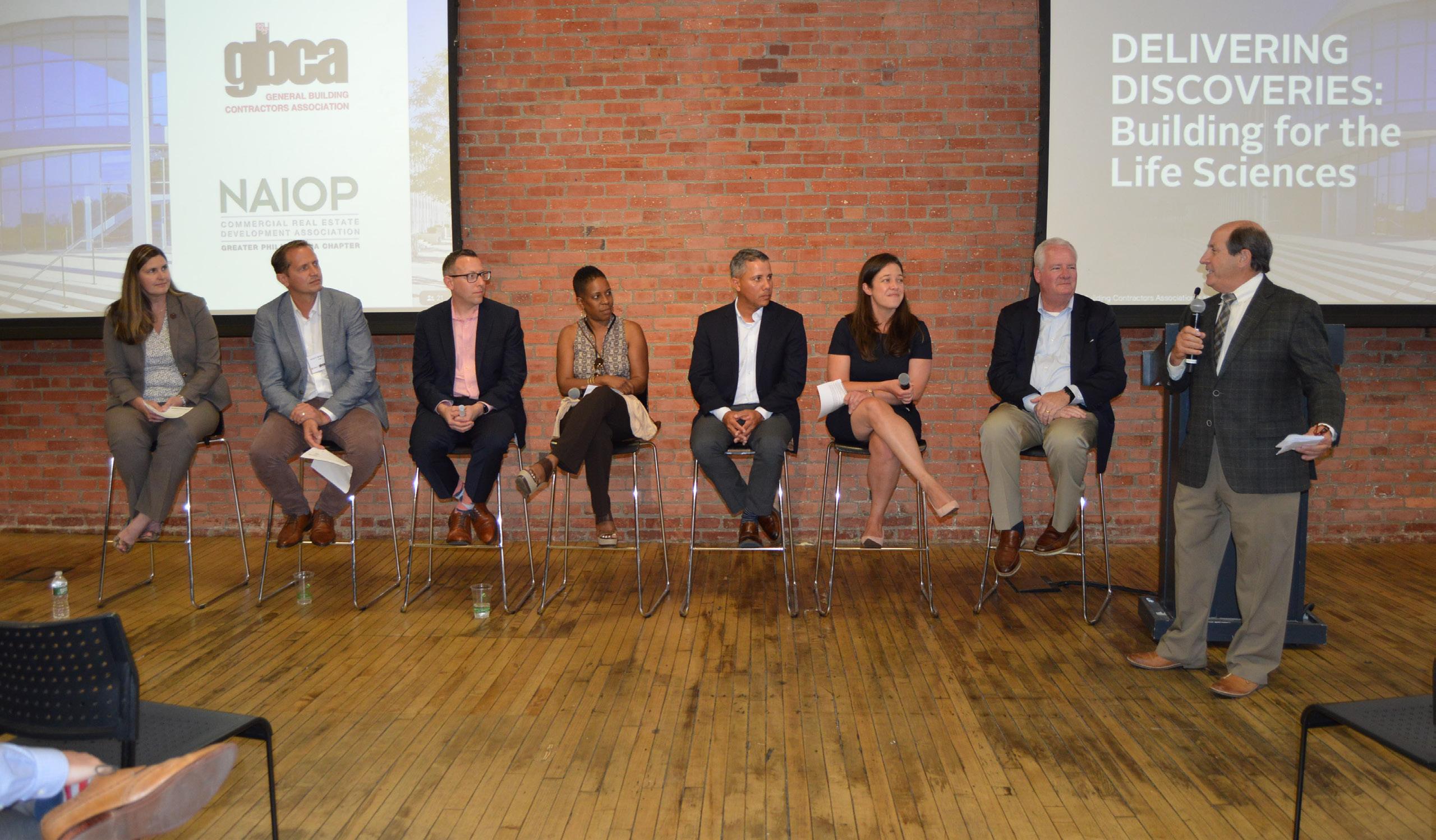
“For the longest time, the prevailing thought in the design world was that it was an architect’s responsibility to protect building owners from being taken advantage of,” notes Levy. “We have come a long way since then. Today more and more architects and constructors embrace that as a joint responsibility and are working together to deliver what’s best for the owners. That’s ultimately what’s best for all of us.”
“We want to make sure we have an open line of communication, which eventually produces a better product for our clients,” says Maura Hesdon, General Manager of Shoemaker Construction Co. and a member of the national AIA/AGC Joint Committee. “We’re also focused on encouraging collaboration earlier and earlier in the design and construction process.”
In fact, research published in 2022 by AIA and AGC found that, unlike in previous years, the majority of architects and contractors strongly agree that the earlier they start collaborating, the better the outcome for the client.
“It all comes down to the fact that no one has all the expertise that’s needed for a project to be successful. But, if we put our heads together, we can come up with some really great solutions,” Levy adds.
In many ways, the industry demands this type of collaborative approach. Hesdon points out that market instability has accelerated the need for architects and contractors to work closer than ever before.
“Supply chain issues are constantly influencing projects in the design phase. For example, when steel became difficult to procure with lead times of a year or more, buildings were being redesigned to remove joists or integrate more concrete construction so projects could continue moving. Without that foresight and communication, clients wouldn’t be getting the best recommendations,” she explains.
Industry leaders also agree that collaboration is increasingly more important because building is increasingly more complex.
“Many professionals don’t realize how complex it is to construct modern buildings that are outfitted with so much technology and so highly customized for their intended use,” says DeFazio. “That doesn’t change the fact that owners are looking for quality, speed to market, and economy. That’s why the more expertise you can bring to the table in the beginning of a project, the better.”
When design and construction are more aligned from the outset, projects can begin as much as a year or two sooner than with a traditional approach that requires a fully complete design before construction begins.
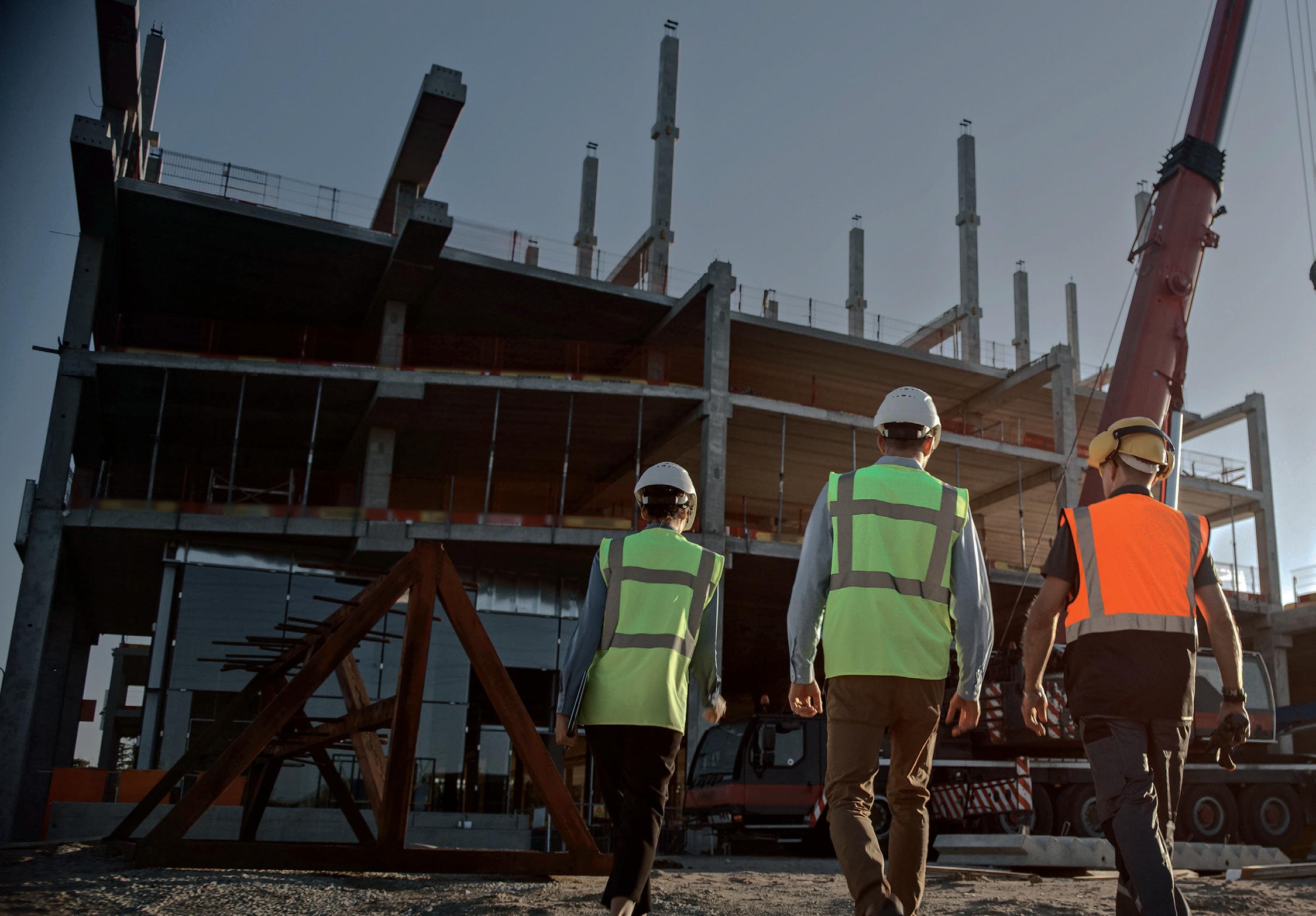
“Every project we do is faster than the one before. Success in this environment happens when we work together,” says Levy. “The same applies when helping owners make the most of their budgets. I’ve personally seen construction costs for a building
component on a project shrink from $8 million to $200,000 thanks to the designers and contractors working together to find a creative solution.”
Significant savings also come from collaborative value engineering exercises, avoiding the legal fees associated with dispute resolution, and eliminating the need for an owner’s agent. At the end of the day, a collaborative construction team helps owners get what they need, what they want, and what they can afford.
Unfortunately, public sector organizations like state universities, school districts, and municipalities are bound by Pennsylvania’s Separations Act of 1913 which mandates a design-bid-build model with a minimum of four prime contractors.
“This legislation eliminates opportunity for collaboration and ends up costing public organizations much more time and money,” argues Hesdon. “These significant clients are unable to embrace different delivery options, but we’re doing everything we can to demonstrate how they, too, can benefit from more collaborative approaches to construction.”
“Safety only works when everyone participates.” That’s a common saying in union commercial construction, but it also represents the all-hands-on-deck approach that’s needed to keep everyone who lives and works in Greater Philadelphia safe.
While various public and workplace safety efforts are underway throughout the region, the General Building Contractors Association (GBCA) is taking the lead with programs that protect the thousands of women and men who are building up our city and suburbs through their work in commercial construction. As the union commercial construction association of Greater Philadelphia, GBCA has long been a leader in an industry where safety is paramount.
The organization, whose members include many of the most well-respected general contractors, is also extending its reach beyond the world of construction to help others stay safe at work and at home.
“Providing the tools and resources that people can use to keep themselves safe — whether they’re on a construction site or simply using an electrical cord at home — is about doing what’s right for our community,” says GBCA President & CEO Benjamin J. Connors, Esq. CAE. “Safety has always been a priority for GBCA, and we’re committed to supporting the wellbeing of Philadelphians in construction and beyond.”
GBCA has a robust lineup of safety resources that are available to its members as well as the construction industry at large. These include in-person training sessions held multiple times
per year, on-demand online safety trainings, OSHA 30-Hour safety trainings, and a free library of mobile-friendly Toolbox Talks to keep safety at the top of minds on jobsites.
“The most successful construction companies all have one thing in common: a culture centered around safety. GBCA helps contractors and their teams foster this type of safetyfirst mentality by making essential information easy to access, easy to digest, and easy to remember,” says James McGugan, a former OSHA outreach trainer who now serves as GBCA’s Safety Consultant.

The association also works closely with local, regional, and national partners to champion crucial safety initiatives at the ground level.
GBCA helps activate OSHA’s annual Focus Four campaign that runs from March through June and features safety lessons designed to counter the four leading hazards on construction sites: electrical hazards, struck-by hazards, fall hazards, and caught in/between hazards. In addition to promoting OSHA’s resources, GBCA offers supplemental toolbox talks for construction teams.
GBCA is also partnering with OSHA for its National Safety StandDown to Prevent Falls in Construction campaign that takes place May 1-5, during which time contractors are encouraged to host all-hands discussions and events at their jobsites to focus on fall hazards and prevention.
As part of this effort, GBCA and OSHA are teaming up with the Mid-Atlantic Construction Safety Council and the Philadelphia
Building Trades Council to highlight the need for fall protection equipment inspections.
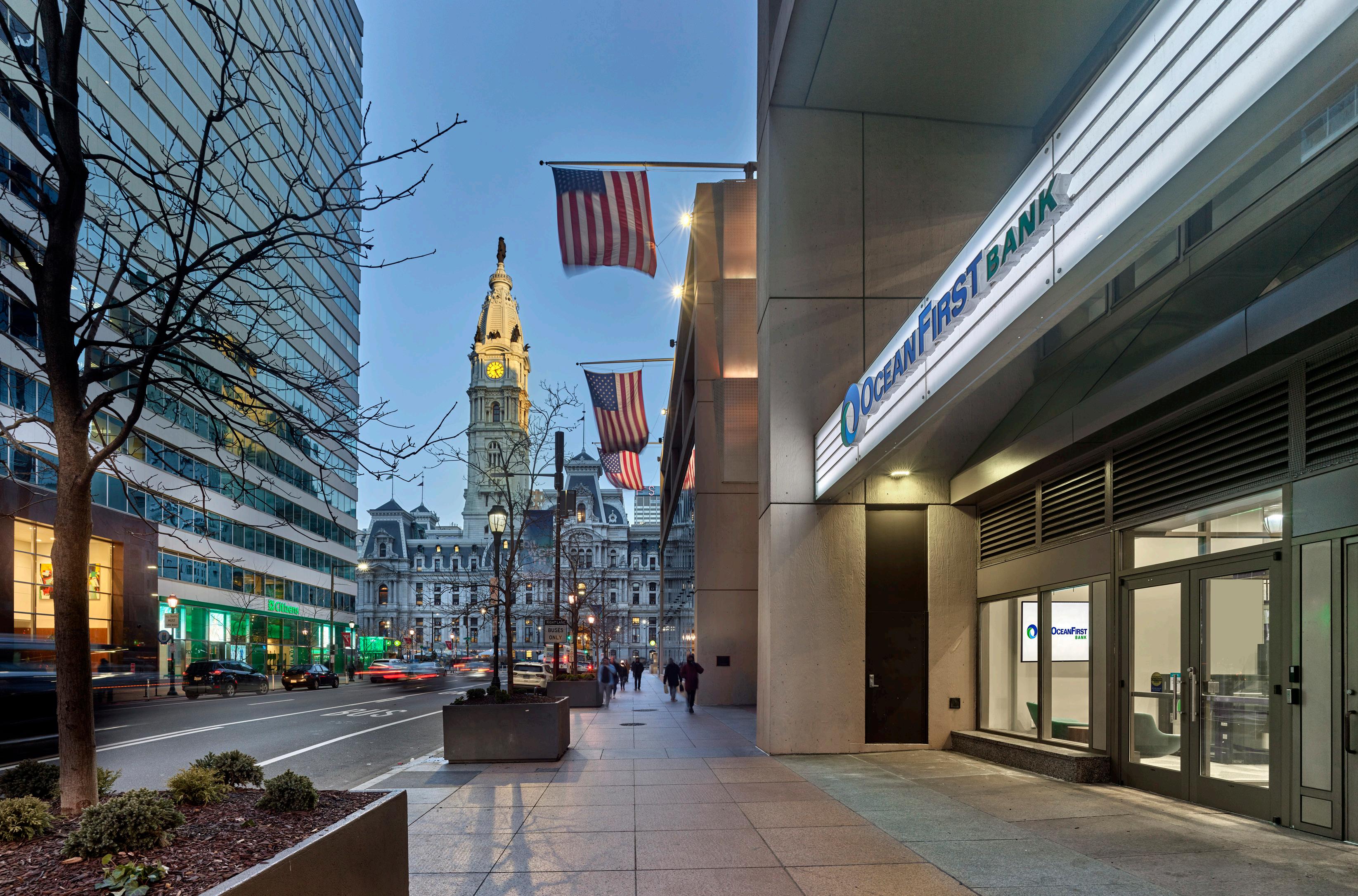
“Safety is all about being prepared, which is why contractors need to proactively inspect equipment and remove any pieces that are in poor condition or past their dates of effectiveness,” says Jennifer Hall, Safety Director at P. Agnes, Inc. and Executive Advisor of the Mid-Atlantic Construction Safety Council. “This joint effort encourages everyone to think about fall protection a bit differently. Faulty equipment isn’t better than nothing — it’s a hazard. By removing this equipment from the field, we’re eliminating fall hazards from jobsites and saving lives.”
Beyond the construction industry, GBCA is taking its efforts a step further by sharing safety tips that the general public can use in their everyday lives more broadly.
“Many of the hazards we see on construction sites are actually the same risks people encounter in other lines of work or at home. They relate to things like using extension cords properly, avoiding slips, trips, and falls, ladder safety, and more,” notes McGugan.
These tips include pointers such as:
• Replace extension cords that are worn or that show exposed wires.
• When going up or down a ladder, always keep three points of contact with the ladder (two feet and one hand, or two hands and one foot).
• Avoid falls by paying attention to where you’re walking and making sure you can see the path ahead, especially if you’re carrying something.
• Avoid distractions like using your phone when walking or driving by active construction sites.
• Remember to take a drink every 20 minutes and rest in a shady spot when working in the heat.
“Safety reminders like these can often make the difference between having an accident and avoiding one,” he adds.
Visit gbca.com for more information and gbca.com/ toolboxtalks for GBCA’s safety resources.
Twentieth century Spanish philosopher José Ortega y Gasset said, “Tell me what you pay attention to and I will tell you who you are.” Whether personally or professionally, the quote seems to strike a chord. So what about your company? What are you paying attention to? Are you chasing culture or compliance? Is your focus on numbers or people?
While the choice is not an either/or, contractors should be asking the question and taking a look at the direction of their attention and efforts. Of course, we must comply with regulatory mandates. But is that enough to ensure that our employees return home to their loved ones at the end of every shift? In the construction industry, the answer is a resounding “no.”
Construction is a risky environment. What’s considered normal in today’s construction industry—including unrealistic schedules and designs that push the boundaries of constructability—was less common in decades past. We’ve adjusted our expectations to fit the new normal, yet we seem wedded to the same focus on compliance. Today’s challenges and complexities require more than mere compliance. Even OSHA officials remind us that OSHA regulations are the minimum, and they encourage employers to structure their safety and health programs to aim higher than these minimum standards. We agree with OSHA’s point—an employer can be fully compliant with OSHA regulations while their employees are at risk of life and limb.
Studies seem to support the benefits of focusing on a healthy company culture instead of obsessing over compliance. A study by the National Safety Council found that companies with a strong safety culture had an advantage over companies without a strong safety culture. This advantage included:
• 54% lower injury rate
• 3.5 times higher productivity rate
• 20% lower workers' compensation costs per employee
Another study, this one by the Society for Human Resource Management, shows that companies that invest in employee well-being and create a positive work environment have a 41% lower turnover rate than those that do not.
Saving lives and preserving the quality of those lives should be priorities in the construction industry. The best way to demonstrate the value you place on your workers, their loved ones, and their wellbeing is through your culture. A culture focused on all workers working safely all the time, rather than a culture focused on chasing numbers that can be manipulated, best ensures that your employees return to their loved ones at the end of each shift, at least as healthy as when they arrived.

Healthy corporate cultures have leaders (from the frontline to the C-suite) who take ownership of safety. Owning safety is different than being held accountable for it. It means that leaders take initiative rather than having it pushed upon them. It also means that leaders weave safety into the fabric of daily activities where it’s inseparable from efficiency, quality, and profitability.
design, smart risk mitigation, and continuous improvement sets a new benchmark for the industry.


Knowing that employees are vital to any company’s success, PDM President Craig Melograno minces no words when empowering his team to successfully navigate the myriad challenges inherent in construction. In a company-wide email, Craig emphasized to his employees “It is so important for us to continue to keep our game at a high level and not fall prey to bad influences. I fully support and will defend every single ‘No’ as a response for stupidity that you might face. Keep up the good work and diligence.”
It means that safety becomes a mindset and a habit, changing our cultures and influencing outcomes. Accountability too often means forcing employees by threat of disciplinary action to adhere to a set of standards. Ownership brings engagement. Accountability instills fear. And fear is toxic to sustainable success. There are no examples of companies that punished and disciplined their ways to safety success and thriving cultures.
PDM Constructors/Durapods (PDM), an ENR 600-ranked top specialty contractor, is a prime example of a company focused on culture above mere compliance. PDM’s cultural journey has been underway for more than a decade and is one of relentless innovation. PDM’s obsessive focus on prevention through
PDM VP of Operations, Mike Jackson noted during a recent presentation at the AGC National Safety Conference that “the real test of a healthy culture is whether it can remain true to its values when under extreme stress.”
Are you ready to take that next step in your culture journey where employees own their role and where they focus on working safely all day, every day? Now is the perfect time.
The real test of a healthy culture is whether it can remain true to its values when under extreme stress.
- Mike Jackson, PDM Constructors/Durapods
OSHA’s reports and training materials regularly report fall hazards as the number one cause of fatality in construction, but a more wide-reaching cause of injury and fatality is not something that be quantified or photographed by a manager or safety professional. This hazard is not weather-related, or due to an engineering or equipment defect. This hazard is about attitude and is easily boiled down to one word: complacency.
Statements like, “We’ve been doing it this way for years, and no one has gotten hurt,” “I’m a professional! I’m good at my job! Why should I change how I do it?” or “Everyone else is doing it that way,” show both resistance to change and complacency towards reported trends in the industry, as if because incidents are from other jobsites, the hazards are not real. Carter and Smith, in their 2006 study on hazard identification1 found that the only 66.5-89.9% of jobsite hazards were recognized by workers. Incident reports and reports of fatalities available to safety trainers today show that a principal cause of incidents was a lack of hazard recognition.
This does not necessarily mean that we are failing to train workers to recognize hazards. What is more likely is that potential hazards are not recognized and mitigated in the daily routine because they did not previously cause incidents or injuries; workers are conditioned to ignore the hazards that have not caused them injury. If the hazard is pointed out, most workers would concede that they see and should have seen the hazard before being directed to it, yet they still fail to address it.
This begs the question: Is the worker the one at fault, or is the responsibility for complacency on the foremen or even more senior supervision?
Do we need new ways to approach hazard recognition and communication, or do we already have the tools to get that job done?
Human performance tools can be an excellent means of combating complacency, at least initially. Tools such as the “Two Minute Drill”, where workers take two minutes to review a hazard recognition checklist before starting a task, usually result in an uptick in hazard recognition and abatement. Eventually, however, these tools often become exercises in going through the motions in order to “check the box” and get to work.

Most construction employers require a Job Safety Analysis (JSA) be performed daily by their managers. If JSAs are required daily, then why do workers still fail to recognize hazards?
A Job Safety Analysis, also known as a Job Hazard Analysis (JHA), Daily Hazard Analysis (DHA), or the nuclear industry’s Task-Specific Job Hazard Analysis (TSJHA), is a hazard recognition framework that breaks down the individual steps in a task, identifies the hazards associated with each step, and then details how the hazards will be controlled via the Hierarchy of Controls. Ideally, this is a cooperative effort between the foreman and the work crew so that tasks are examined from multiple perspectives and are specific to the jobsite. The completed cards are kept for reference during the shift and returned to the safety department at the end of shift. Most employers expect
the foreman to turn in a JSA card for each job assignment as part of their managerial duties, so that there is pressure to get the card completed and submitted.
The JSA is designed to be a cooperative effort, but oftentimes foremen will complete the JSA prior to examining the jobsite and simply have workers sign the card. Foremen are often rated by their supervision and safety department by how well JSAs are completed. Schedule discipline is often a cause for glossing over the JSA process, as foremen do not want to delay work, or have it appear that the crew is “wasting time” pointing out deficiencies to address. Workers are then inadvertently prompted to think that there are no new hazards to be addressed, often overlooking changes that could present new hazards.
Employers often use the phrase, “schedule never takes precedence over safety,” but how often is this just lip service? If construction employers don’t ensure that employees are encouraged to recognize and correct hazards—even if it impacts schedule—we will likely continue to face fatalities and serious injuries to workers. Here are some suggestions to help correct employee attitudes that may lead to complacency:
1. Refuse to accept “this is how we’ve always done it” as an acceptable defense of an employee’s actions. Any worker who shows resistance to coaching or other corrective measures can become a hazard.
2. Understand that a “culture of safety” means more than having safety meetings that give lip service to safety. Slogans alone do not prompt workers to evaluate their work areas for hazards.
3. Incentivize safety. Most safety professionals understand that recognizing good safety practices with something as small as a $5 gift card can go a long way.
4. Make the JSA process a cooperative effort as was intended. Encourage front line supervisors to assign coordination of this process to individual employees (with supervision) on a rotating basis. Get everyone to take ownership for the crew’s safety.
5. Make PPE a priority. One of the first steps in combating complacency is ensuring that workers realize the importance of properly wearing PPE to avoid preventable injuries, especially while performing repetitive and intermittent hazardous tasks.
Human performance tools help employees to recognize hazards. Yet employees are still unnecessarily injured or killed due far too often to a failure to recognize what are nearly always preventable hazards. Management and safety departments, as a key component of a culture of safety, must take the lead and focus on combating complacency on their jobsites every day.


For many of us in the construction industry, mental health awareness is often a neglected aspect of worker health and safety — but it’s never a bad time to be proactive and take charge of our well-being as it pertains to mental health and self-awareness. As the year begins, many of us are focused on recent objectives, goals, and initiatives. For others, the sparkle of the new year fades as additional challenges develop and the “attempt to change for the better” is slowly forgotten. In construction, however, we need to remain sharp, especially to maintain safe jobsites.

The World Health Organization defines mental health as, "[a] state of well-being in which the individual realizes his or her own abilities, can cope with the normal stresses of life, can work productively and fruitfully, and is able to make a contribution to his or her community."
How can we incorporate well-being and mental health into our everyday processes? We can start by examining it through our physical, emotional, internal, and external experiences.
Improving diet, prioritizing exercise, improving sleep patterns, and taking time to relax are critical steps to engage your body’s response to stressors — and to create meaningful outcomes. Simple things like listening to music, going for a walk, and meditation are all physical ways to improve your mental health.
Positive psychological well-being can reduce the risks of heart attacks and strokes. On the other hand, poor mental health can lead to poor physical health or harmful behaviors and chronic diseases. Since the start of the coronavirus pandemic, Americans have reported a significant increase in depression, which has been linked to numerous chronic illnesses.
Emotional and mental health are intertwined and often treated interchangeably. The emotional side focuses on being in tune and aligned with our emotions, vulnerability, and authenticity. Having a good foundation of emotional health is a fundamental aspect of fostering resilience, self-awareness, and overall contentment. Characteristics of good emotional health are
strong self-awareness (with focus on accountability and accurate perception), emotional agility, strong coping skills, living with a purpose, and the ability to manage stress.
Internal struggles can develop from stressors, deflection, and suppression, and each one can affect how we think, feel, and act. Some common internal stressors include an inability to accept uncertainty, pessimism, negative self-talk, unrealistic expectations, lack of flexibility, rigid thinking, and a need to always be perfect. We then may react with deflection to either throw others off course or mask a situation. Another response is to suppress feelings and thoughts. Stressors and deflection are internal responses that occur automatically and without mental effort — but suppression is a controlled, conscious effort that requires mental resources.
Mental health issues also present themselves in external ways. Unlike internal struggles, these issues have direct impacts and results that can be recognized by other people. Lack of sleep, unhealthy food, and alcohol can all affect your body externally. Alcohol has an effect on neurotransmitters, changing how your body would normally operate. Another recently identified factor that affects people externally is social media, which many have found to have the most profound effect on our mental wellness.
To remedy some of these external effects, people are often encouraged to spend time in the sunlight to manufacture vitamin D, connect with people to prevent loneliness, and find a way to review positive and informative social media posts while avoiding negative stories.
The external factors discussed here can lead to direct and indirect behavioral changes. If not addressed, they can activate aggression, pattern shifts, and inconsistent responses — all behaviors that can negatively impact problem-solving skills and cognitive thinking.
Take the following steps to improve your mental health and develop cognitive, emotional, social, and physical resilience for a fulfilling life:
• Adapt to change – remain flexible and open minded
• Establish your immediate circle to surround you with healthy and inspiring relationships
• Increase your self-esteem – take time to reflect on yourself to feel valued and empowered
• Feel secure – be comfortable with your decisions
• Practice living a balanced life – remember that it’s okay to say “no” to things
• Encourage self-confidence by believing in yourself and pushing for personal growth
• Remember the “3 R’s philosophy” – Rest, Recharge, Reset
• Prioritize health, whether it’s physical, emotional, or mental

In the construction industry, we make decisions every day. Sometimes our decisions are based on previous memories, education, or newly gained insights. We are presented with challenges, opportunities, and experiences that need our attention and we have to be able to face these encounters with clarity. We have many engineered and administrative tools that support our work to keep us safe. We have compliance standards that are expected to be followed to ensure safe operations. The one tool that needs the attention to detail, repeated care, and


support isn’t on the worksite; it’s not in the job box or in your work truck — it’s your mind. Your mind is the most important, the most powerful, and the most impactful tool you have; it is carried by you and serviced by you, and you rely upon it day in and day out.
Taking steps to make positive changes in your life and improve your situation starts with knowing where to find available resources. These resources start at the local level and extend to county, state, and national levels. Your company may have an Employee Assistance Program to connect with and get support. Phone apps such as Calm, MoodKit, and iBreathe can assist with planning and supporting your goals and needs. Your community — family, friends, churches, community organizations — may also be able to connect you with helpful resources or provide you with the support that you need.
If you or someone you know is in crisis or mental-health related distress, please call the Suicide and Crisis Lifeline at 9-8-8
Your mind is the most important, the most powerful, and the most impactful tool you have.
Transportation analytics firm INRIX recently conducted a study and found that Philadelphia ranks fourth on the list of cities with the most congestion based on hours spent in traffic per year. In 2022, Philadelphians spent 114 hours sitting in traffic. While the Bureau of Labor Statistics reports approximately 150,000 injuries on construction sites each year, these statistics do not include vehicle accidents off-site, even if involving construction vehicles. Vehicle accidents are, in fact, a leading cause of death or serious injury in the construction industry. The three most common causes of vehicle accidents are speeding, driving while impaired, and distracted driving.
Speeding is dangerous because it leads to increased stopping distance. At 65 MPH on dry pavement, a standard vehicle will need over 340 feet to come to a complete stop – the length of a football field! Today, we can also provide more accurate estimated times for travel: Most people use navigation systems that will give drivers an estimated time of arrival and some will even take into account traffic along the route. Rarely will a driver beat this ETA by a significant amount of time, even with speeding. At 60 MPH you travel one mile in one minute and at 70 MPH you will travel one mile in 51 seconds. Especially in the city, however, factors such as traffic, stop lights and signs, and road conditions make speeding less likely to help get you to your destination significantly faster.
Driving while impaired has been one of the leading causes of vehicle crashes for many years and since the pandemic, the Pennsylvania Department of Labor and Industry reports an increase in the number of workers reporting to work intoxicated or even using alcohol and using drugs while on duty. Most companies have implemented drug and alcohol policies to help
prevent this and some even offer employee assistance programs to help workers. For more information on substance abuse programs, contractors can visit the PA Drug Free Workplace or Substance Abuse and Mental Health Services Administration websites.
Many people are unaware of the danger, or have a more relaxed attitude towards distracted driving. The National Highway Traffic Safety Administration (NHTSA) reports that distracted driving, especially while texting, is six times more dangerous than impaired driving. They also report that composing a text slows a driver’s reaction time by 35%, while drinking alcohol up to the legal limit slows reactions by 12%. Reading, sending, or responding to a text can take your eyes off the road or your hands off the wheel (if you’re not using voice-activated dictation) for about five seconds. At 60 MPH, you will travel over 300 feet and not be fully dedicated to the task of safe driving.
While many vehicles have Bluetooth capabilities, the primary distraction is the actual conversation itself. Studies on inattentive blindness, such as “Failures of Awareness: The Case of Inattentional Blindness” by Dr. Daniel Simons, Professor of Psychology at the University of Illinois, show how individuals can fail to see something that is unexpected in plain sight due to a lack of attention. Since the pandemic, workers saw an increase in virtual meetings, and many individual are taking these meetings while driving. This diversion from paying attention to the road is dangerous and ideally, companies should prohibit this behavior.
Contractors can prevent these unsafe behaviors by implementing programs and technologies that encourage safer driving habits while on the job.

All contractors should have a written fleet safety program that is communicated to all drivers. An effective written fleet safety program that includes basic rules, driver selection, drug and alcohol testing, driver training, road tests, motor vehicle record checks completed annually and time of hire at a minimum, distracted driving, disciplinary procedures, and vehicle maintenance.
This policy should also include motor vehicle record checks (MVR). At a minimum, the MVR should be run annually and at time of hire. Contractors should look back at least 3 years and assign a value to each moving violation based on severity. Certain violations such as DUI, excessive speeding, at fault accidents and fleeing the scene of accident should automatically exclude the driver from operating a company vehicle.
Driver training should be incorporated into every fleet safety program. Educate drivers on the dangers of speeding and driving while distracted, as well as defensive driving principles. All drivers should receive defensive driving training at time of hire and take at least an annual refresher training. There are many online and in-person courses available.
Telematics are GPS based systems that include onboard diagnostics that track the vehicle’s location, speed and harsh events. They are typically managed by third party vendors that will send data directly to the client. This data will alert management in real time when a driver is speeding or is involved in a harsh event. As a result, companies can use this information to identify at risk drivers for retraining or disciplinary action. It is imperative that contractors address unsafe driving behaviors.

Dash cameras, front and/or rear facing, are designed to record when the vehicle is on. In the event of a crash, this video footage can be extremely valuable evidence to insurance adjusters when determining which driver was at fault. Footage can also be used to dispute claims where a driver deliberately backs into the car behind them and claims to have been rear-ended. These incidents are on the rise, so this footage can prove invaluable to contractors.
Most construction contractors and companies understand the need for jobsite safety procedures to prevent workplace injuries, but what about getting to and from the job sites? An effective written fleet program along with strong substance abuse programs, driver training and technology can help mitigate the risk.

Anchor Hoist
Brock Industrial Services
Shore Building Contractors, Inc.
Tracey Mechanical Inc.
Compliance Management International (CMI)
CompuData
Conspectus, Inc.
Diversified PHL, Inc.

Hillmann Consulting, LLC
Merchants Bonding Company
BUILDING MATERIALS
Tague Lumber, Inc.
See our ad on the back cover.
FINANCIAL
McCarthy & Co., PC
See our ad on page 22.
Rosenberg & Parker
See our ad on page 27.
Wouch, Maloney & Co., LLP
See our ad on page 23.
GENERAL CONTRACTORS
E.P. Guidi, Inc.
See our ad on page 07.
HSC Builders & Construction Managers
See our ad on page 31.
LF Driscoll
See our ad on the inside front cover.
P. Agnes, Inc.
See our ad on page 35.
Torcon, Inc.
See our ad on page 29.
LEGAL
Cohen Seglias Pallas Greenhall & Furman PC
See our ad on page 23.
SAFETY CONSULTANTS
HazTek Inc.
See our ad on the inside back cover.
SPECIALTY CONTRACTORS
CIPPCO Inc.
See our ad on page 31.
Component Assembly Systems, Inc.
See our ad on page 19.
Eureka Metal & Glass Services, Inc.
See our ad on page 35.
Herman Goldner Co., Inc.
See our ad on page 23.
Med-Tex Services, Inc.
See our ad on page 33.
IMAGINiT Technologies
See our ad on page 07.
Microsol Resources
See our ad on page 37.
Milwaukee Electric Tool Corp.
See our ad on page 07.
PCS, LLC
See our ad on page 37.
The pandemic hit us hard but the collective strength, resolve, and resilience of the HazTek Team has allowed us to do more than just survive. We became stronger. We expanded our team, stepped into leadership roles, developed virtual training capabilities, and instituted pandemic-specific health and safety protocols for our customers. We pulled together as one and embraced our mission to enrich the health, safety, and well-being of our employees, our customers, and our communities.
We aren’t the same company we were before. We’re the new HazTek. Bigger | Stronger | Safer.
